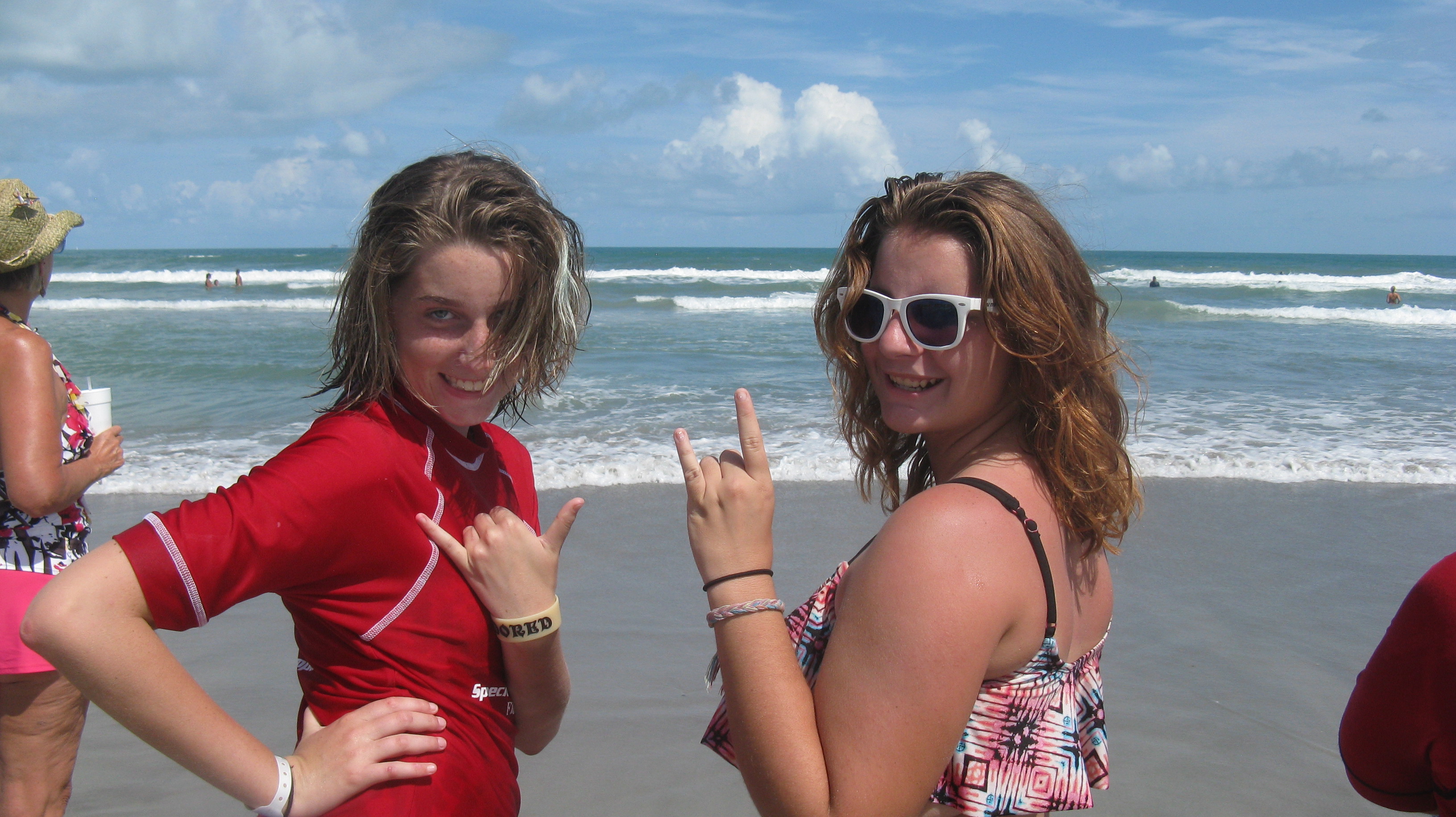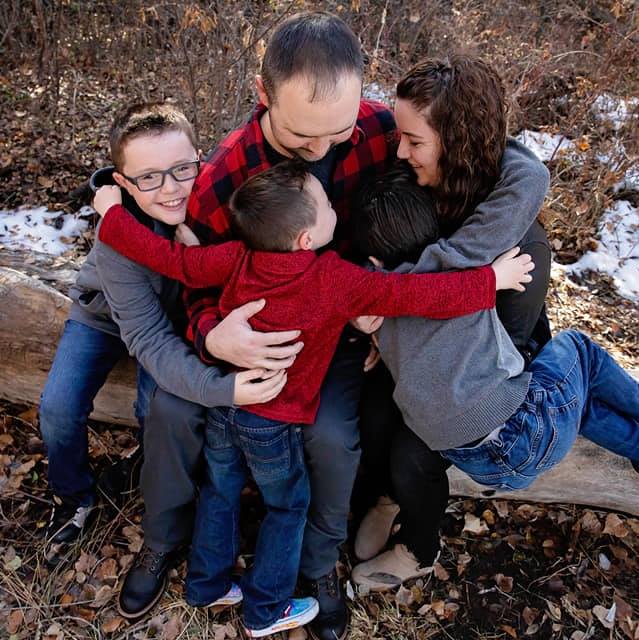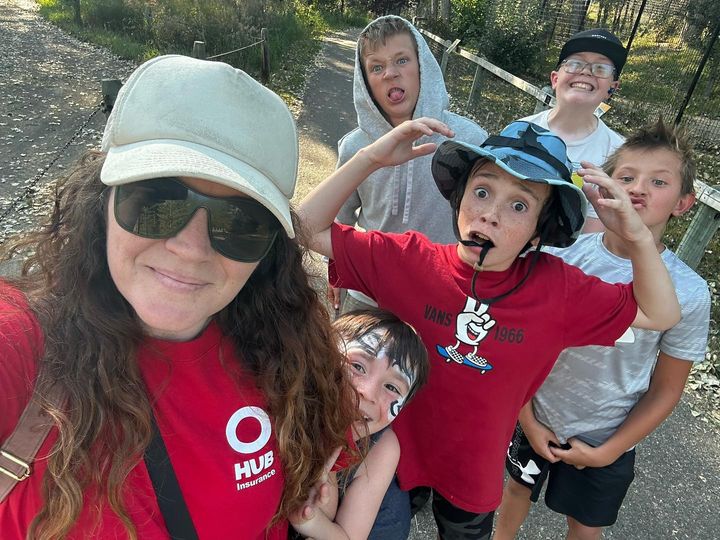NATURE PLAY STEAM FAMILY FUN ACTIVITIES ADVENTURE NATURE CRAFTS
Nature Playdates:
Activities, Adventures, Quests, and Challenges

The movement to combine environmental education with early childhood education has been on the rise, coinciding with concerns that children do not have the same opportunities to experience nature as previous generations did. The significant increase in the number of nature preschool and forest kindergarten programs operating in the United States is one indicator of the growth of this movement. But what happens when you want to offer early childhood nature programming but don’t have the space, personnel, logistical, or monetary support to run a full-scale preschool? One answer may lie in short-form programming such as nature playdates.
Recently, I conceptualized and created a weekly nature-focused one-hour-long playdate for the Pinelands Institute for Natural & Environmental Studies (PINES) in New Jersey. Here are some lessons I learned and steps you can take to develop a similar program at your own nature or environmental center!
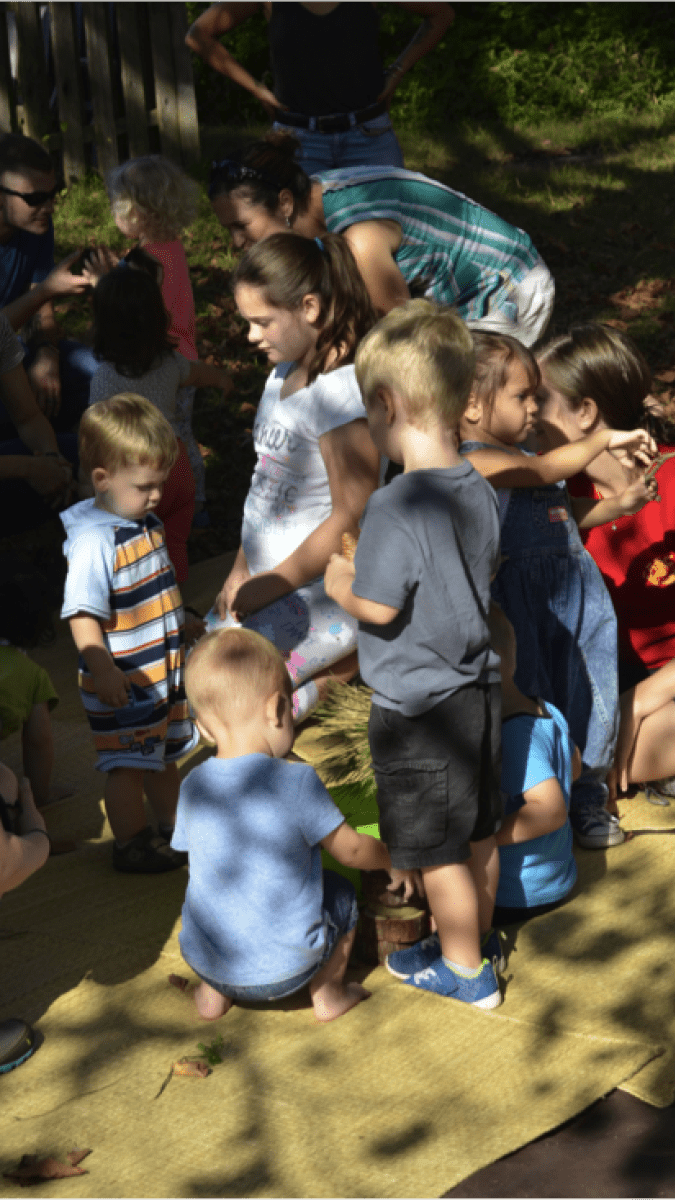
Exploring loose tree parts at a PINES Playdate. Photo courtesy of Jessica Grill and the Pinelands Institute for Natural and Environmental Studies (PINES)
Designing Your Playdate
There are quite a few considerations to be aware of when designing a nature playdate. Many logistical decisions behind program design ultimately hinge on what resources are available within your facility. Following established early childhood environmental education guidelines, program ideas should be filtered through your individual context to build a fun program that is developmentally appropriate for the age groups being served. I found that many institutional goals and audience needs can be identified by answering the questions of Which, What, When, Where, Who, and How:
Which age group(s) will your playdate focus on? Will it be a single, mixed-age group program, or multiple, single-aged group programs? Will it be a drop-off or caretaker-child program? Additionally, how many participants can you safely and effectively accommodate? A wider range of ages will lead to opportunities for play between older and younger participants such as siblings. A narrower range will allow you to pursue more specific developmental goals, such as fostering the visual and tactile senses in the early years or developing vocabulary and questioning skills in the preschool years. Settling on an age group will also help you to answer the next question:
What format will your playdate follow? Will it be structured, following a schedule with designated times for specific activities, or will it be freeform, open for participants to freely explore natural materials and environments in a controlled setting? Perhaps a mixture of structured activities and free time for exploration? What sort of activities will the playdate include? Science? Storytelling? Art? Active play? Many activities traditionally done with young children indoors can be done outdoors, with both natural and manufactured materials. At PINES, playdates feature monthly themes (birds, frogs, trees, etc.) supported by topical discussion, hands-on activities, and related songs, stories, and manipulative materials. Your choices are almost endless but the activities and format you select should provide children with plenty of opportunities for joyful interactions with nature.
When and how often will the playdate run? Once a week? Biweekly? Multiple times a week? Will it run for an hour, like many toddler-focused programs, or for a longer period of time? Try to pick a time for your playdate that falls between most families’ standard schedules, such as meals and nap times; often, mid-morning and mid-afternoon are best. If your aim is to serve a specific population, try to conduct an informal survey of a few parents or talk with other professionals who serve that same population to make a more informed decision about the schedule that best fits your target audience’s needs.
Where will the playdate be held? Do you have a space on your grounds that is open enough for exploration yet defined enough for a group of young children? Is the space compatible with your program’s format – does it have loose natural parts for creative play, for example, or a shady tree for storytelling? How will you enclose the space, if needed? And are you able to identify and remove structural and environmental elements that might be hazardous to young children? A stroller-accessible location close to the parking area and/or a main building often works best. An ideal location is also easy to bring supplies to, provides enough open space for the children to get up and move, but is defined enough to ensure their safety. Using the same space every time builds familiarity and comfort in participants.
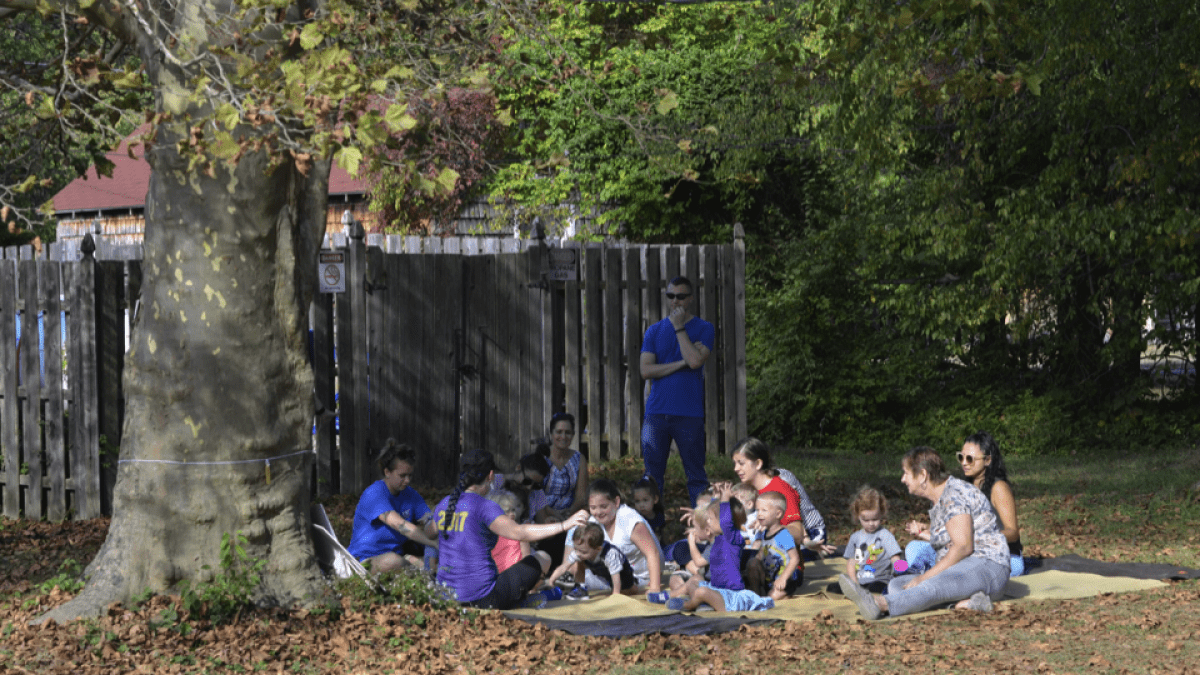
This location is marked by large trees, a fence, and one side completely open, with mats on the ground to visualize the space. It provides enough security for the parents and enough freedom for the children during focused activities. Photo courtesy of Jes
Who will supervise and run the playdate? Do they have the proper training to facilitate play and learning? Understanding your staff’s abilities and comfort levels will be crucial for answering these questions. The roles of the educator in a nature playdate is to maximize children’s opportunities for play and exploration, model care and respect for nature, respond to children’s interests and fears about the natural world, and intervene when children’s safety is at risk. You can look for workshops, conferences, or professional association meetings near you that can help to build your staff’s capacity to work with young children.
How much will you charge for your playdates? Will the program require pre-registration or can participants simply drop-in? Is there a discount for paying up-front for multiple playdates? How will you handle inclement weather – will you cancel the program and issue refunds or will you move it indoors? Requiring pre-registration, even with a nominal fee, allows you to know more exactly how many participants, and what ages, to expect at your program. In my experience, families attend more consistently when they pre-register, especially when they pay a discounted fee for multiple playdates. Providing incentives to participants to return can also help to form friendships and a sense of community in the group.
Spreading the Word about Your Playdate
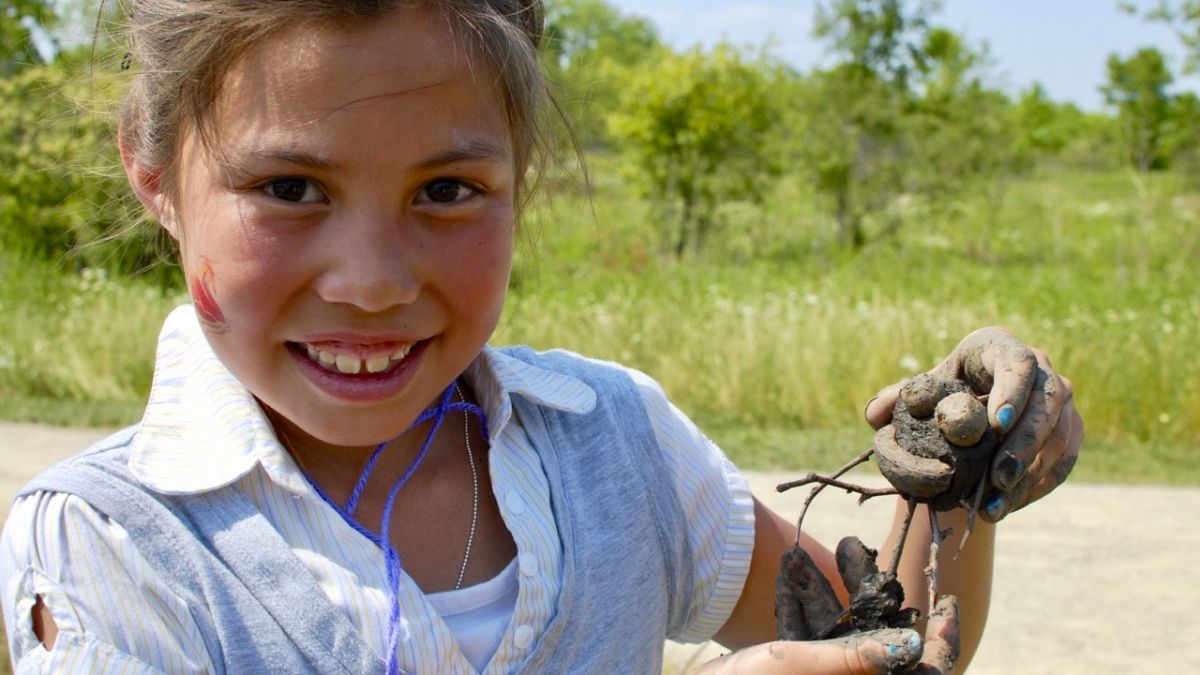
Young children don't need any special materials or toys for joyful, creative play. Photo courtesy of Emilian Geczi
In our modern world of seemingly endless choices, effective marketing can be a deciding factor on whether a program will be successful or not. One effective technique is finding a niche community who may not be aware of the opportunities your center provides and working with them to tailor a playdate to their needs. Likewise, social media, local family resource centers, and online “mommy groups” are fantastic resources that can help you reach your desired audience. Harness the power of modern “share culture” with attractive images and bulleted “to-the-point” information. And never underestimate the power of word-of-mouth – one parent who loves your program can influence many others to join. With proper marketing, a playdate program can fill up in just a couple weeks!
Playtime!
George Forman, professor emeritus of education at University of Massachusetts, Amherst & past president of Jean Piaget Society, once said “Children do not need direct instruction to play. But, they need the partnership of another mind, older and equally curious, with which to wonder out loud”. At the end of the day, this should be the goal of a nature playdate program, and indeed, any play opportunity. With ample time and thorough planning, any organization can create short-form nature play programming. In addition to requiring relatively few resources, nature playdates can be more accessible to families who enjoy being out in nature but don’t exactly know how to meaningfully introduce their children to the natural world. As educators, we have the opportunity to be a support structure and help parents build that bridge between the outdoors and their children.
85+ Simple Backyard Nature Activities
THINGS TO DO JUST OUTSIDE YOUR BACKDOOR
Exploring nature with kids doesn’t have to mean hitting the trail, heading to the mountains or going camping (though those are all fine ideas). Connecting with nature is as easy as heading out the back door.
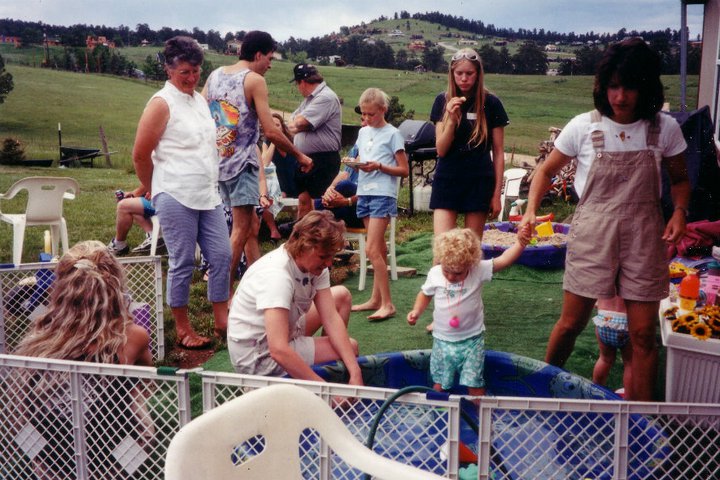
I hope this blog will give you some ideas to make exploring nature in your backyard simple and fun. And don’t worry if your backyard is tiny or even nonexistent – the ideas I share can be enjoyed at a local park or any other natural area in your neighborhood.
Where should I start?
If you only have a few minutes to peek around, bookmark this page! Then check out the top five Backyard Nature Fun reader favorites:
How can I search your archives for more great backyard nature fun?
I’m glad you asked! The best place to start is back on the home page, where you’ll find the Backyard Nature Fun posts sorted by season (look right under the blog’s logo). You can click on any of the seasons for timely play ideas. Or you might prefer to enter a term into the search bar in the top right-hand corner of the page to see what comes up.
To get you started right here, I’ve featured the top three reader favorites in a variety of topic areas.
Gardens/Flowers/Trees
Gardens, flowers and trees can be usually be found in just about any neighborhood, making them a simple way to connect with nature.
Holiday Activities
Here’s where you’ll find ways for families to get outside and into nature during the holidays.
Idea Lists
I like making lists. All kinds of lists. Which is a good thing, because they seem to be pretty popular around here.
Imaginary Play
One part magic, one part imagination, this is where nature and imaginative play come together.
Nature Crafts
I make no claims to be crafty, but most kids are huge fans of crafts. Thankfully, nature and crafting go together nicely.
Nighttime Nature Activities
Sometimes it’s fun to explore nature when the sun goes down. See some of the activities we’ve tried.
Rainy Day Fun
Wondering what to do when it’s pouring outside?
Scavenger Hunts and Nature Walks
Here you’ll find plenty of ways to turn an everyday walk around your backyard, neighborhood or local park into an adventure in nature.
Simple Pleasures
It doesn’t take a lot for kids to have hours of fun outside. A little dirt, a little sand and a little water will often do the trick.
Snow Play
Winter’s snowy weather is no excuse to stay indoors. If you need some ideas for getting outside, we’ve got a few.
Sun/Sky/Wind
Short on time? Sometimes connecting with nature is as simple as taking a look up.
Wildlife Watching
Even our urban backyard is teeming with wildlife – birds, bugs and more.
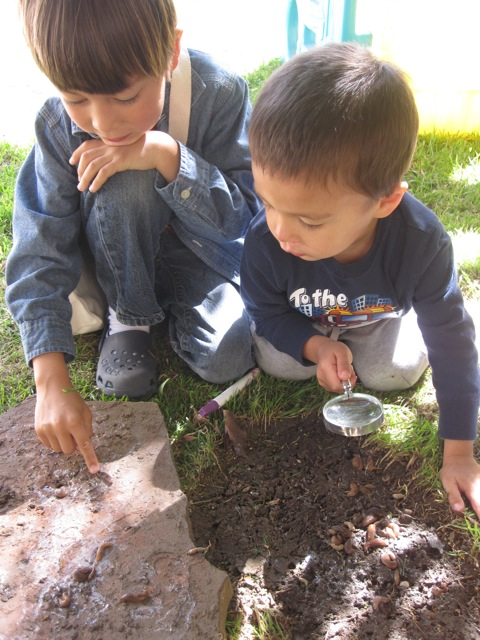
try one of these 50 ways to explore nature in your ownbackyard. Most require only a few minutes of time and a good dose of curiosity.
1. Go cloud watching
2. Build a fort
3. Climb a tree
4. Roar at the moon
5. Go on a nature scavenger hunt
6. Plant a garden
7. Create a backyard beach
8. Explore a flower
9. Run barefoot through the grass
10. Dig in the dirt
11. Follow an ant trail
12. Camp out in your backyard
13. Tour your neighbor’s front gardens
14. Take a color walk
15. Jump in puddles
16. Go on a backyard birdwatching expedition
17. Bake mud cakes
18. Raise a caterpillar; release a butterfly
19. Build a fairy house
20. Make leaf, rock or bark rubbings
21. Start a backyard field guide
22. Create rock art
23. Gaze at the stars
24. Plant a tree from seed
25. Play with sticks
26. Build snow animals
27. Watch a sunset
28. Go butterfly watching (and maybe catch a few!)
29. Host a backyard garden tour
30. Keep a moon diary
31. Run through a pile of leaves
32. Start a seed collection
33. Paint with mud
34. Take a flower walk
35. Create a fairy garden
36. Plant a flower
37. Search for spider webs
38. Go on a backyard safari
39. Explore a tree
40. Design a backyard hiking trail
41. Create a treasure map
42. Enjoy a backyard campfire
43. Go on a bird watching scavenger hunt
44. Make a birdfeeder
45. Start a nature journal
46. Paint rocks
47. Create land art
48. Take a compass walk
49. Make sand angels (snow angels are nice, too)
50. Go on a backyard bug hunt
Small World Play

Have you heard of small world play? In this type of play, children can build or create and imagine, all in a small, safe and manageable ‘world’ of their own making. It’s imaginative play, only it’s more contained, often in a space that your child can return to again and again.
What is small world play?
Small world-play is a way of creating (and recreating) scenes and settings, both real-life and imaginary, in child-size proportions. Like its close ally imaginative play, small world play allows children to explore and consolidate things they experience and learn in real life, and to see the world from the perspective of others. But unlike imaginative play, small worlds are, as the name suggests, smaller and more contained, often with clear boundaries between where the play ends and the rest of the world begins. Doll's houses, play farms and other settings inspired by the real world are classic examples of small world toys. But children can just as easily make their own small worlds in places of their own devising; a shoe box, on a Lego base, under a table or in a quiet corner of a room. There are no rules.
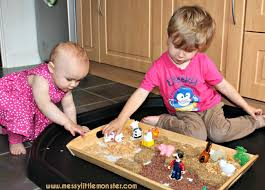
The benefits of small world play
You’ll notice that small world play is especially popular with toddlers and younger preschoolers. This is because it’s a great way to explore and expand on the language skills they are acquiring so rapidly at around 18-24 months. Listen to your child as they play with their small world and you’ll probably hear a constant narrative as they act out the very exciting events that are taking place in their small world setting. So if you are trying to help a child with sounds and words, encouraging small world play will reap rewards.
Some toddlers prefer to play by themselves, engrossed in their own plots and explorations but as the grow, children start to play alongside each other and eventually collaboratively. Nowhere is this more evident than with small world play, where preschoolers will happily co-create scenes and stories, learning to share and consider others as they go.
DIY Small World Play Ideas
Choose your subject
Big or small, real or fantastic, it’s up to you. Choosing something your child is already familiar with is a good idea, so that they can build on what they already know and feel confident. Or choose a topic that they love...like gardens, fire station, dragons, princes and princess theme.
Zoos and farms are always good as most children love animals and know of some already through family pets or trips.
Keep it simple
Whatever scene you’re creating, try to limit it to just one space and around two or three characters or animals. Too much going on will overwhelm them. Concentrate instead on finding a good mix of materials and textures, especially natural ones. For example you might create an underwater scene in a shoe box, with sand for the sea-bed, a natural sponge and a few shells.
Early Dramatic & Pretend Play Dynamics
When they play with figures and props in this type of sensory rich setting, children often recreate scenes from everyday life. It’s also a way to use their personal interests, favorite places and storybooks: and turn them into themes for sensory based small world play. Even when the play is about fictional characters, it's almost always - on a subconscious level, at least - about the child's own experiences. For example, observing dollhouse play allows you to see what your child understands of family dynamics and gender. Who takes out the bins? Who does the cooking? Whose house is it? It's also a chance for children to enjoy role-playing situations not normally open to them: answering the door to the postman (or a tiger!); going to work; cooking dinner.
A Few Tips
Let your child take the lead. It’s not open-ended if you’re taking charge or setting goals!
Allow mistakes and mess to happen. Since there is no end-product in sight, open-ended play is relaxed. Tidying as you go may ruin their train of thought.
Don’t help your child fix something or do it ‘the right way’, unless they ask you for help.
If they do ask for help or you want to help maintain momentum, try to get them to solve the problem first. Open-ended questions are most useful because they have to think about the answer. Why is it like that? Who could live here? How will it stay together? You’ll know it’s going well because your child is deep in thought, lost in the activity.
WOODLAND PLAYDOUGH ACTIVITY
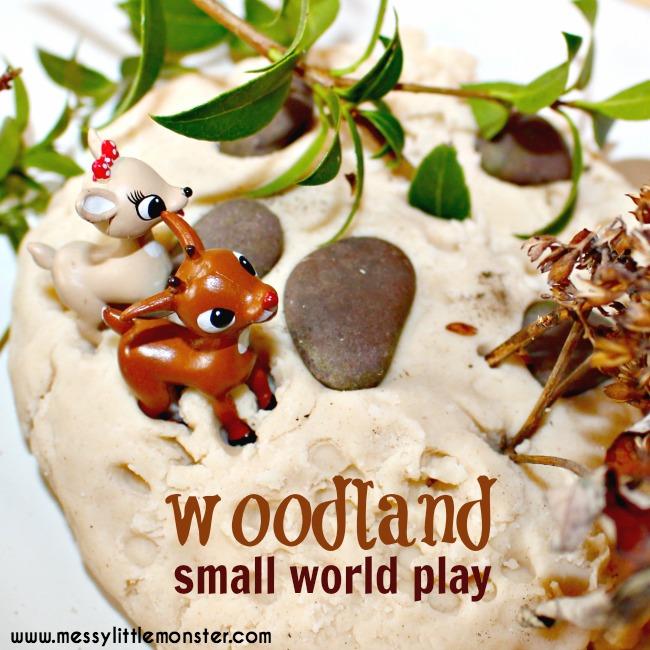
Have fun creating a woodland small world from playdough and nature. Toddlers and preschoolers (as well as big kids!) will love collecting nature and arranging it in playdough to create a cute small world. Add a few toy animal figures and these miniature scenes are perfect for imaginative ...
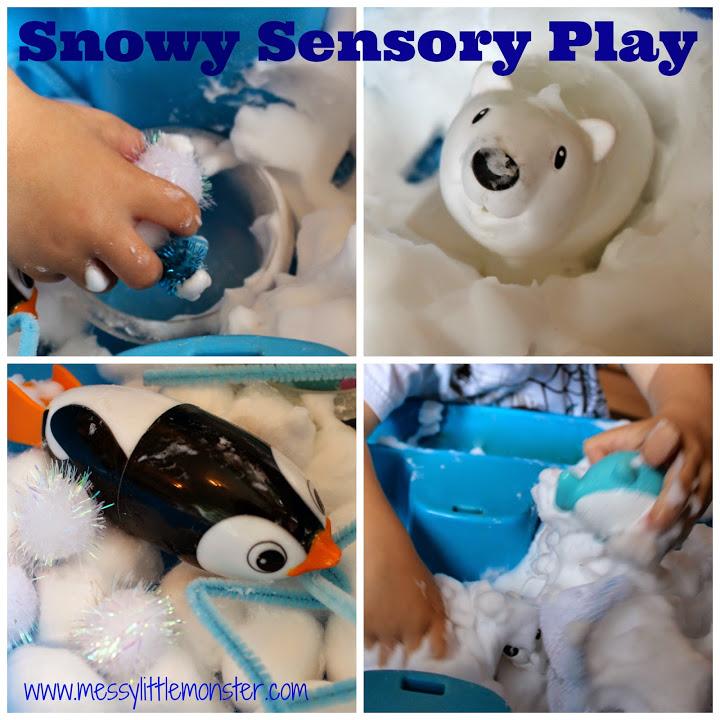
SNOWY SENSORY PLAY WORLD
Foam soap is the perfect ingredient for snowy sensory play (and clean too which is an added bonus!) Toddlers and preschoolers will love investigating and exploring the different textures in this small world winter scene. ...

EDIBLE FARMYARD SMALL WORLD PLAY
Babies, toddlers and preschoolers can safely play with this edible farmyard small world. There is no worry about them putting things in their mouth as everything except the figures are edible. Kids will love the sensory aspect to this play and using a tuff tray keeps all the mess ...
7 Book Inspired Small World Play Ideas
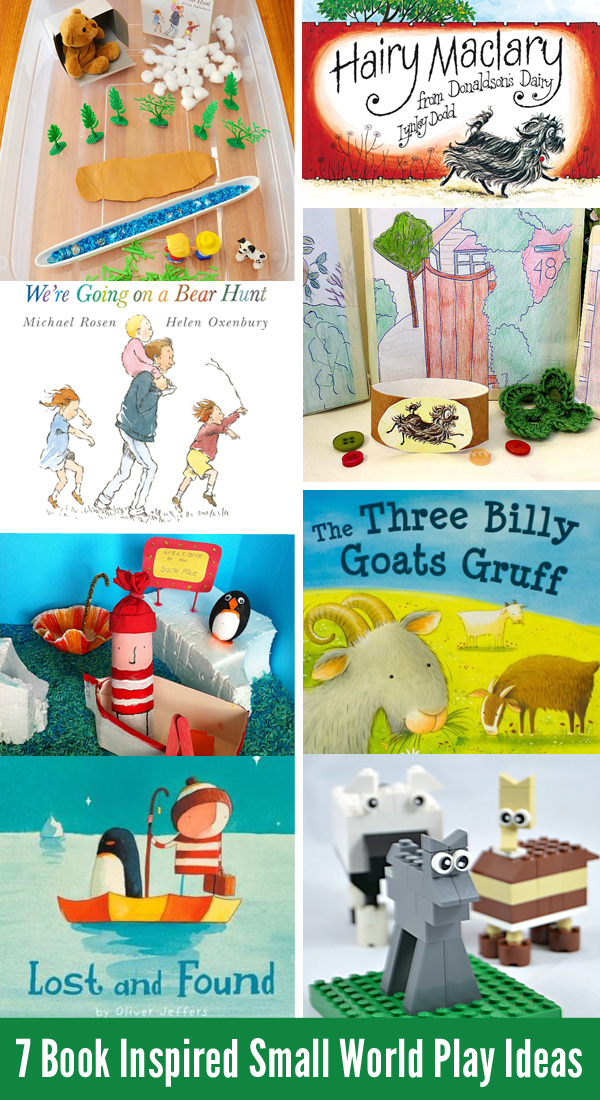
My kids love imaginative play and presenting a small world as an invitation to play is guaranteed to engage them for hours. And creating a small world based on a fabulous picture book has the added bonus of encouraging their use of lots of wonderful language and comprehension skills as they are inspired to retell the story, explore the characters and make up new stories of their own! Here are 7 fun book inspired small world play ideas that I think your children will love as much as mine do.
We’re Going On a Bear Hunt Small World
Find out more about the book: We’re Going on a Bear Hunt by Michael Rosen
Hairy Macleary Printable Small World via Little Worlds
Find out more about the book: Hairy Maclary from Donaldson’s Dairy by Lynley Dodd
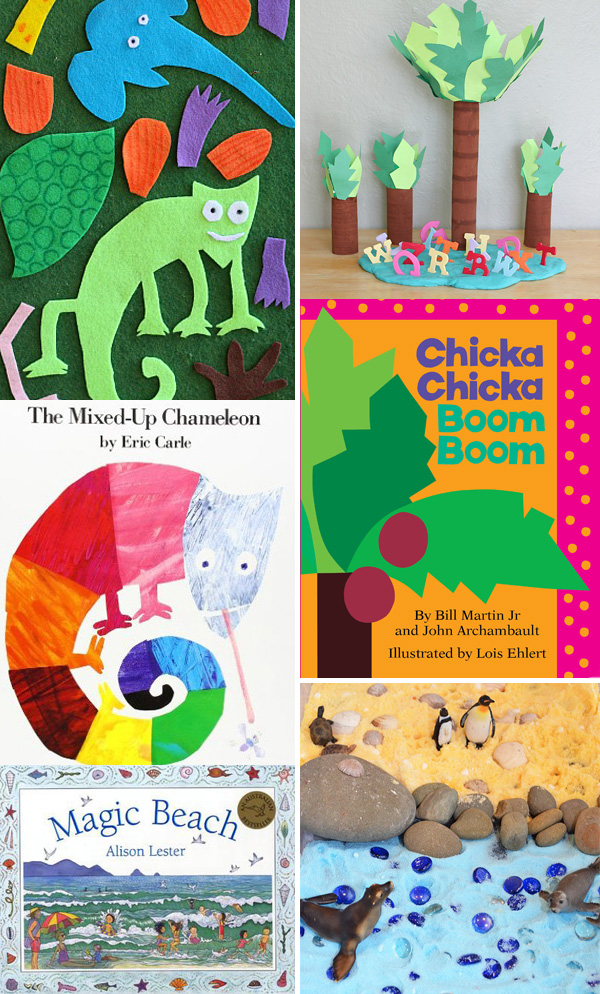
The Three Billy Goats Gruff Lego Small World Play via Growing Book by Book
Find out more about the book: The Three Billy Goats Gruff by Paragon Books
Lost & Found Small World with found materials via One Perfect Day
Find out more about the book: Lost and Found
The Mixed Up Chameleon Felt Board Story Play via Buggy and Buddy
Find out more about the book: The Mixed-Up Chameleon by Eric Carle
Chicka Chicka Boom Boom Play Set via Buggy & Buddy
Find out more about the book: Chicka Chicka Boom Boom
Salty Beach Small World via Picklebums
Find out more about the book: Magic Beach by Alison Lester
10 Beginner Mini World Play Ideas
Small world play is great. You have all the benefits of pretend play with the added bonus of being able to make half the stuff yourself. I’m a big fan of the kids playing with their own craft activities.
They also have the additional benefit of including a whole heap of other types of play. It all depends on your imagination to see how many different ways you can play with the same toys.
There are less pieces in a toddler small world play but more of a sensory focus compared to a preschool small World. The size of the elements also need to be larger to be safe for toddlers. Not sure what I’m talking about? Don’t worry, I’ll give you some examples as we go to show you.
Here are 9+ mini world play ideas to get you started.
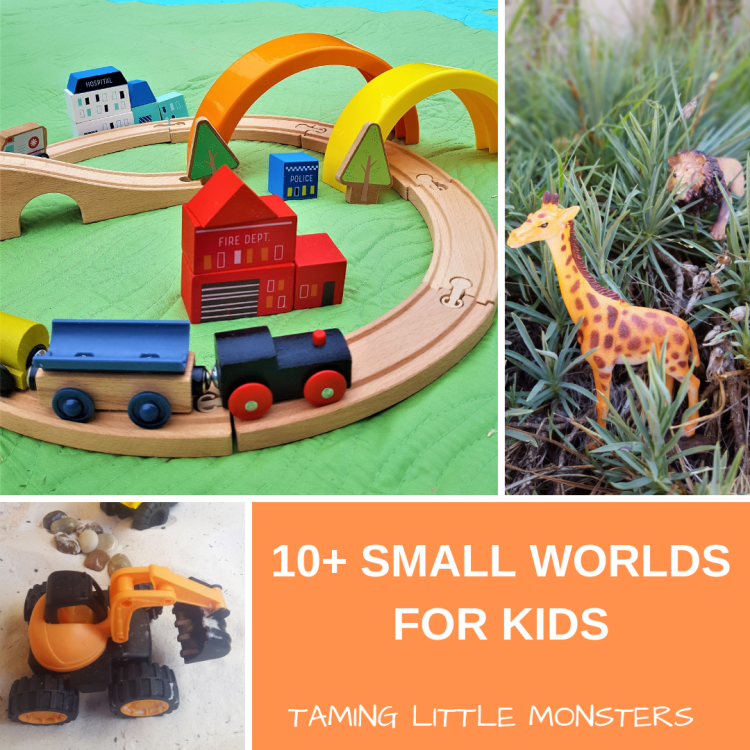
DIY Aeroplanes & Airport
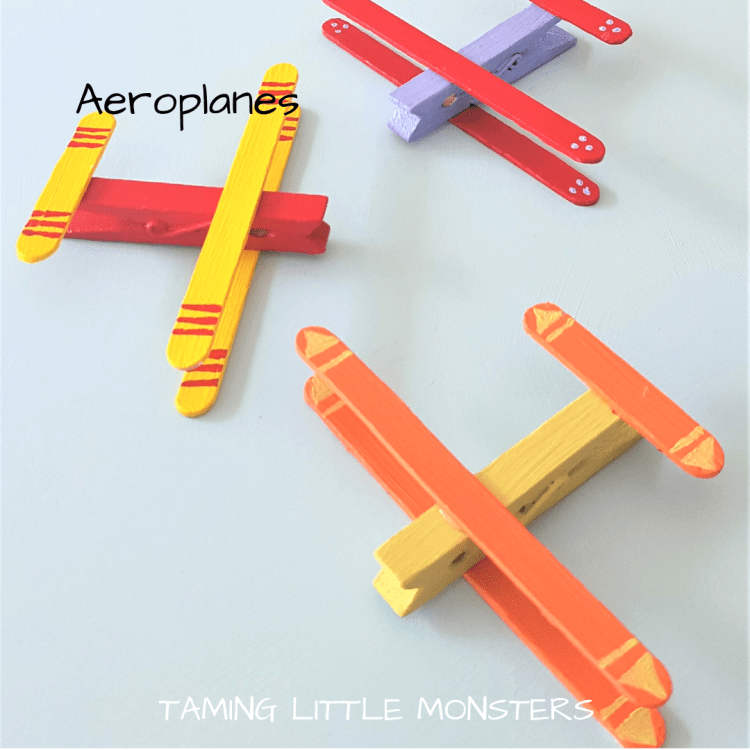
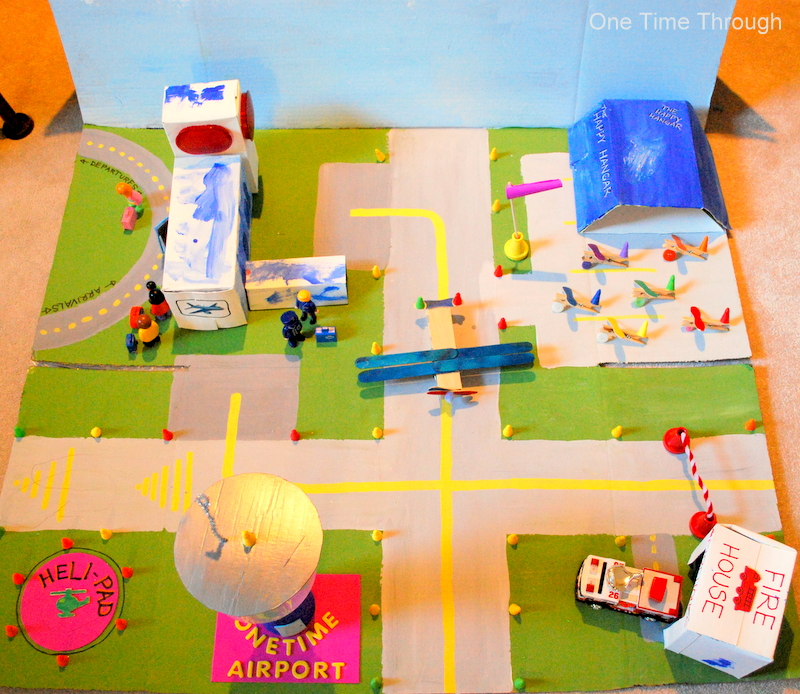
These aeroplanes started off as a craft project. First I glued some popsicle sticks to a wooden clothes peg, then we had a lot of fun painting them. I love how they can then be used to play with as mini world aeroplanes. I also don’t care if they break because then we have an excuse to make some more.
For a more in-depth tutorial for how to make these clothespin airplanes have a look at the post Clothespin Plane Craft from One Time Through. Not only will you learn how to make these adorable peg planes, but you’ll also get to see their awesome cardboard airport.
African Safari or Zoo
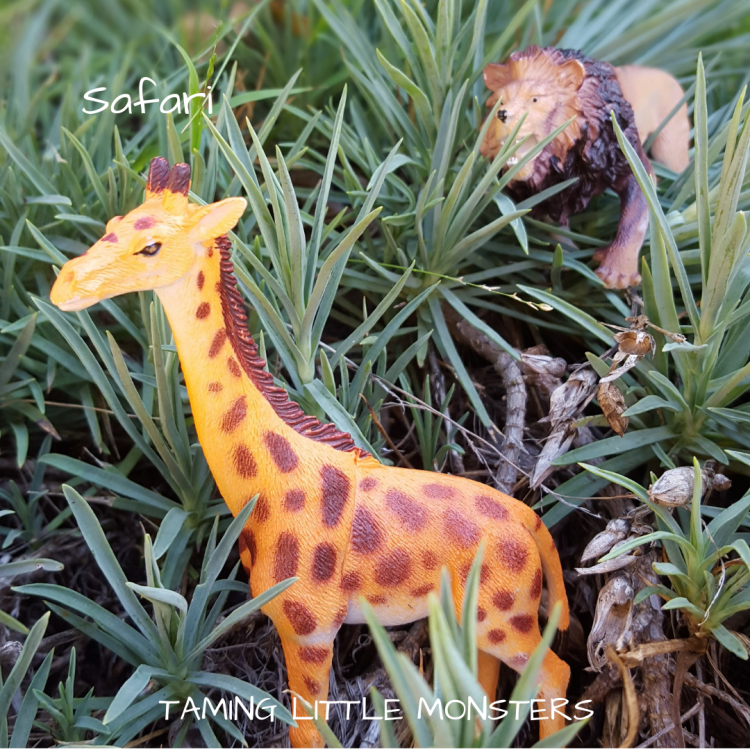

Who doesn’t love exploring the savannah with the lions and elephants? There’s something about African animals that kids love and we’d be silly not to use that to our advantage. So get out your lions and crocodiles and see if they can catch any of those monkeys.
If you’re familiar with the Cheeky Monkeys and the Crocodile song, I have a free printable that’s just for you. This Cheeky Monkeys Counting Game helps kids to count from 1 – 10 and they get to have fun being monkeys and running away from the crocodile afterward too.
Mini World Boats
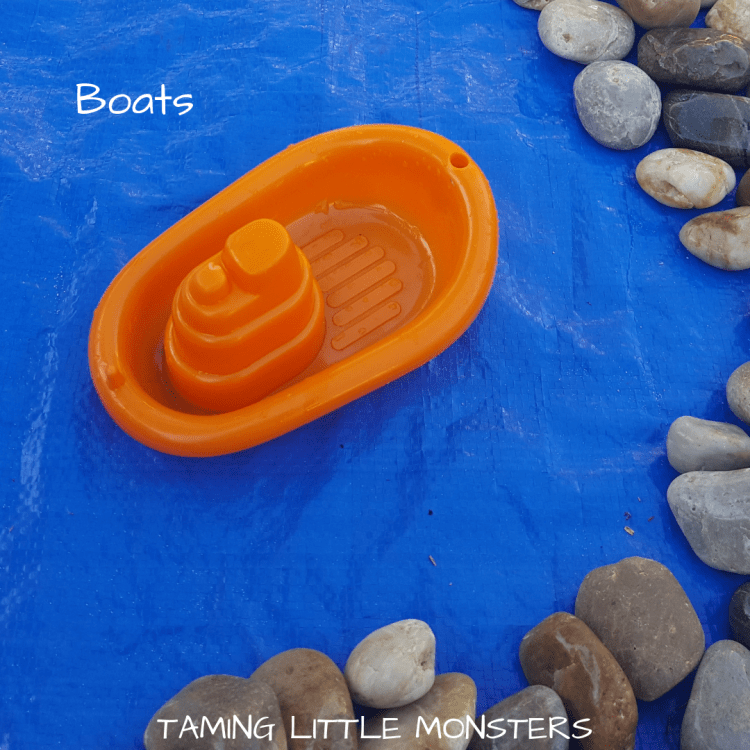
Boats are definitely a bath time staple. However, they shouldn’t be left in the bathroom because it’s limiting. Adding pebbles, sand and water to this mini world is a great recipe for a sensory play session too. Boats can go sailing across the garden, or get stuck on a sandbank in the sandpit. The pebbles can be dropped in the water to see what kind of sound and splash they make. Not to mention just exploring the different qualities of wet vs dry sand.
If you don’t have any boats on hand, don’t worry. I’ve found that a shoe works just as well.
Ice Cream Store
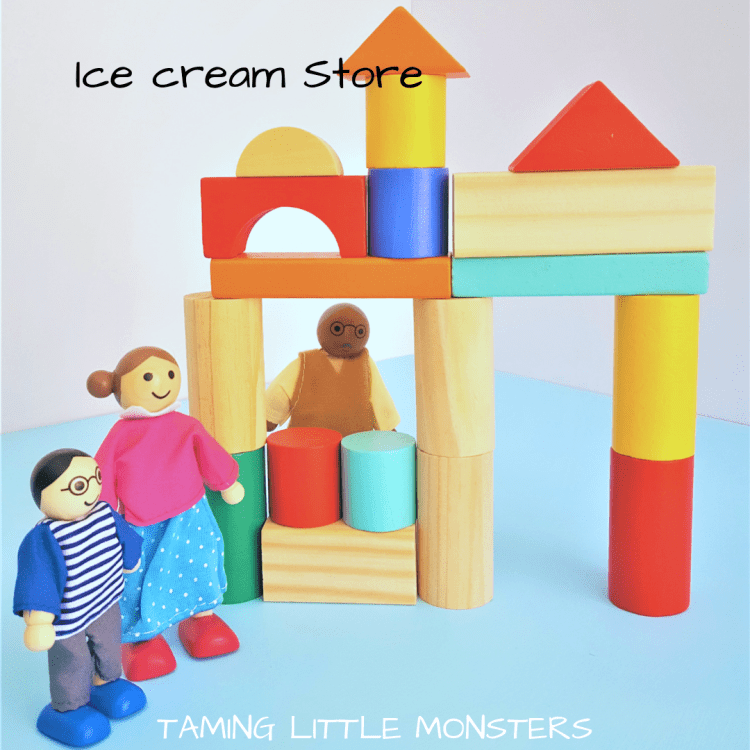
Ahh ice cream. Who doesn’t love heading out to the local shop and buying a cone? The best part about this one is that it’s perfect for talking to your kids about how to behave in public. Using their manners, for example, or how we can’t take things without paying for them.
It’s also a good chance to talk to your kids about ‘sometimes food’ and ‘everyday food’. That’s exactly what my free food sort printable is all about. It’s one printable that can be used in 3 different ways. It helps you to teach your kids about healthy eating without actually having to fight with them about eating their vegetables.
Dragon races
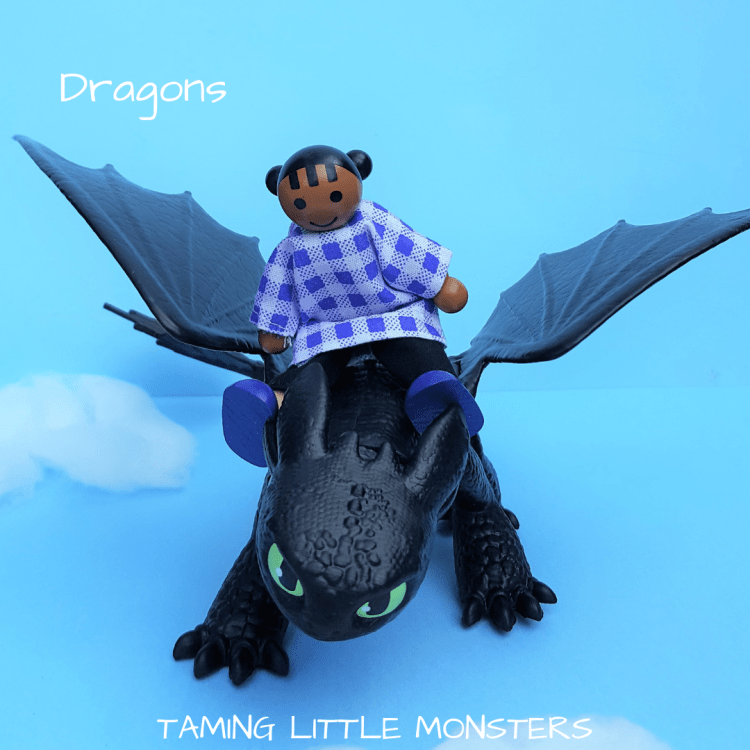
My son loves dragons. So having our very own dragon races through some cotton wool clouds is always a fun activity for toddlers. You can always create an outdoor obstacle course for your dragons by hanging some glow stick rings to fly through. Or perhaps your kids would prefer going on a scavenger hunt for the hidden black sheep.
If your kids love dragons, then give this Dragon Treasure sensory bin from Inspiration Laboratories a try. Or this Dragon Themed Positional Word Game from The Educators Spin on it. There is so much fun to be had with dragons.
Mini World Cars
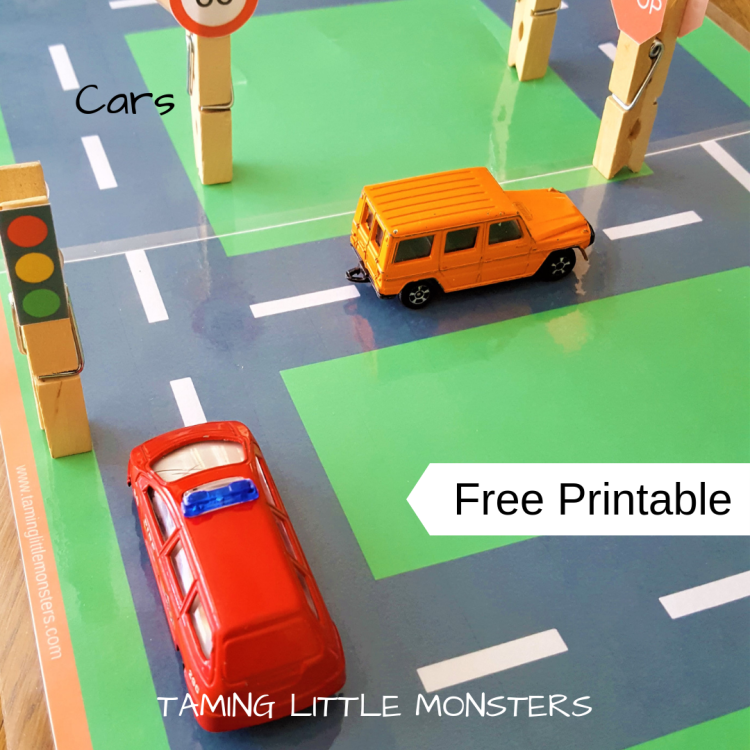
Cars are big with all children, not just boys. They’re great to add to your list of travel bag activities too. After all, it’s so easy to just grab a couple and put them in your handbag. Download THIS free road map printable, which you can laminate and doubles as a placemat for when you’re dining out. Preschoolers will enjoy the road signs I’ve included in the free printable. Glue them onto some wooden clothes pegs and they can set up their own intersections and construction zones.
Now you can keep your little ones entertained while you enjoy a meal out with the family.
If your kids love cars, be sure to try these Car STEM experiments. There are 3 easy experiments to introduce your kids to physics. If your kids are still young, don’t worry, my toddler absolutely loved playing with the different setups anyway. He loved watching the cars roll down the ramps and seeing how far the roll.
Farm Mini World
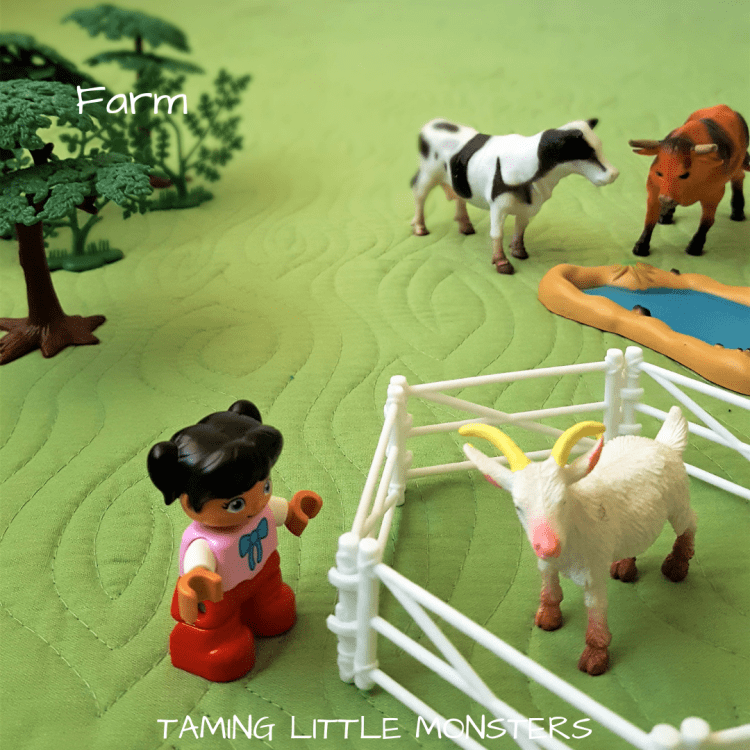
“Moo” goes the cow. “Baa” goes the sheep. Farm animals are so much fun to play with. They each make their own noises and kids can have a bit of fun being silly and making those animal sounds. If your children love farm animals, then check out my farm animals printables page. It’s got free printable coloring in pages and activities. If you add some corn to this small world it becomes a wonderful sensory bin. Be sure to read my 10+ Sensory tubs for Toddlers post. There are some wonderful messy and sensory play ideas for toddlers. My Frozen Peas Sensory Bin is perfect for farm pretend play. There are three different toddler activities in this one sensory bin.
Mini World Construction Site and Trains
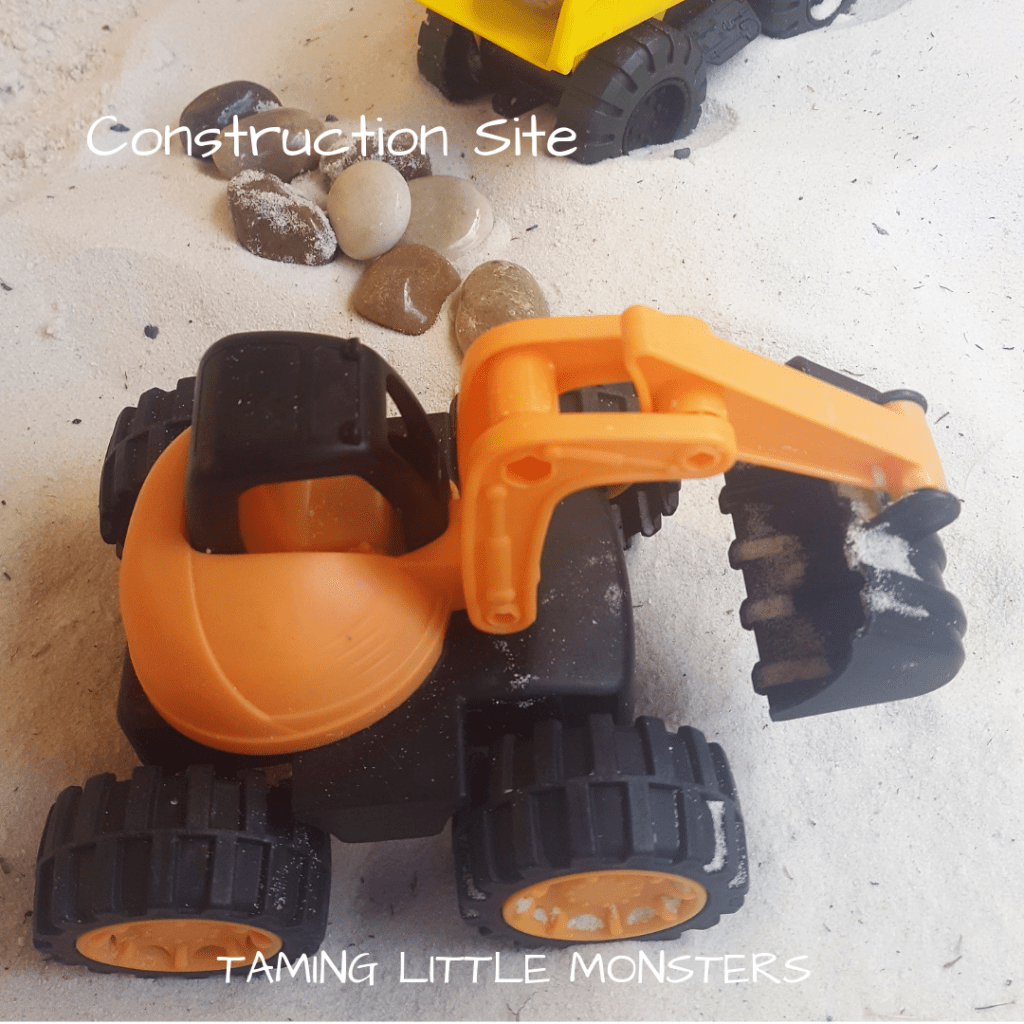
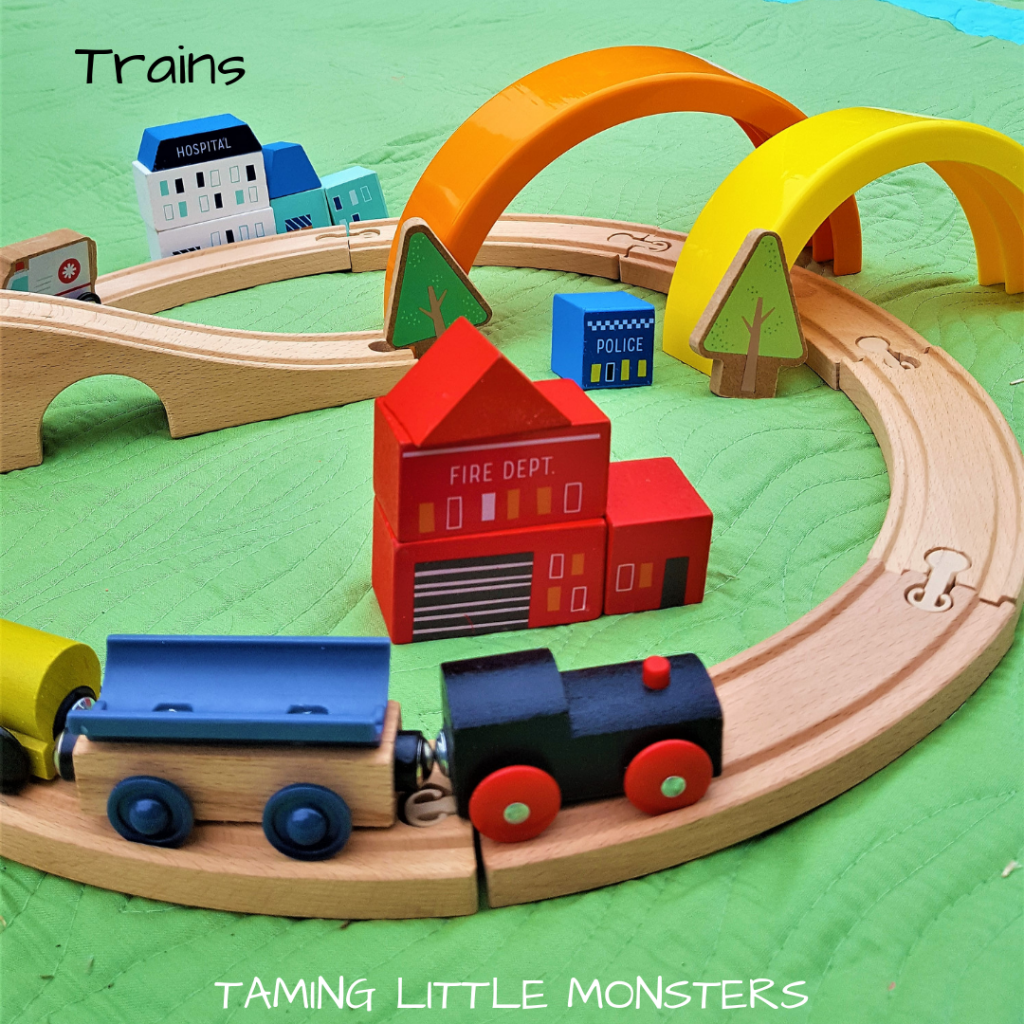
The sandpit is a staple in most playgrounds, or backyards if you have one. There’s something magical about playing with sand. Maybe it’s just because it’s so versatile so there’s always something new to try in there. Building your very own construction site, is one of them.
Add your very own DIY Road Blocks from Little Lifelong Learners and you’ve got the perfect setup for play.
We also use these fantastic DIY Road Blocks when we play with our trains. They make wonderful bridges so that the cars can go over the train tracks.
Under the Sea
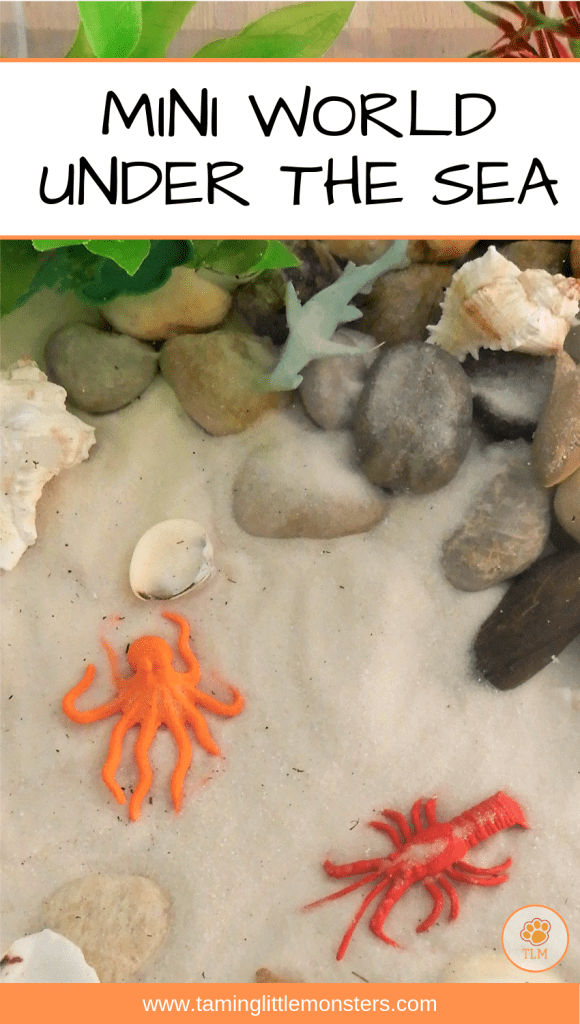
Where’s Nemo? With this underwater small world, your kids can go find him. That’s not all there is to this activity either. If you add some shells, fake seaweed, and some sand, it doubles as a great sensory tub too.
If your kids love ocean animals, check out this post on 5 Sea Creature Crafts for toddlers. They’ll love making their very own rainbow rice fish or egg carton turtle.
Duck Pond
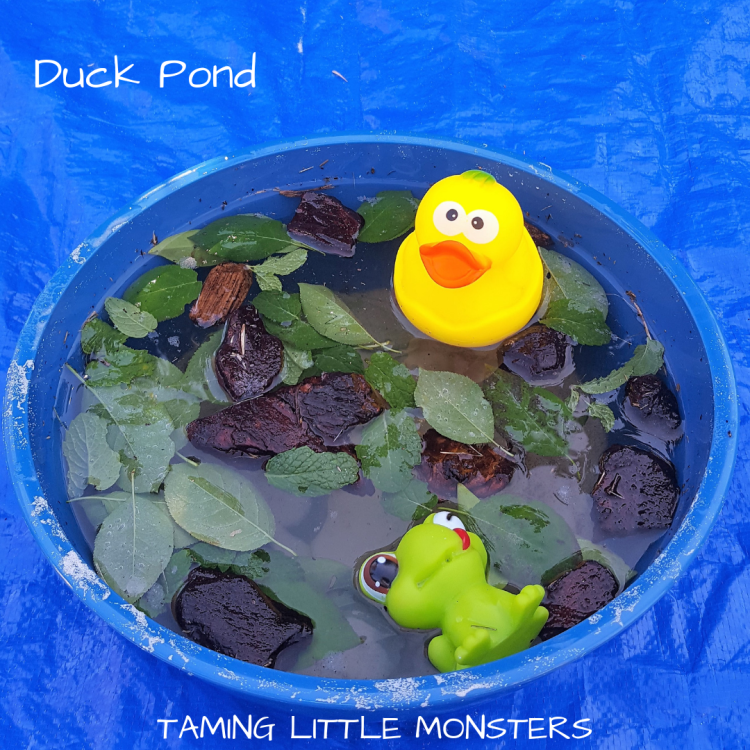
This duck pond actually started as a float or sink experiment for my toddler. I originally saw the idea from Happy Hooligans and knew that we’d love it. When we finished experimenting with different items from the garden I noticed that we had inadvertently created the perfect place for our rubber ducks to go swimming.
Dinosaurs
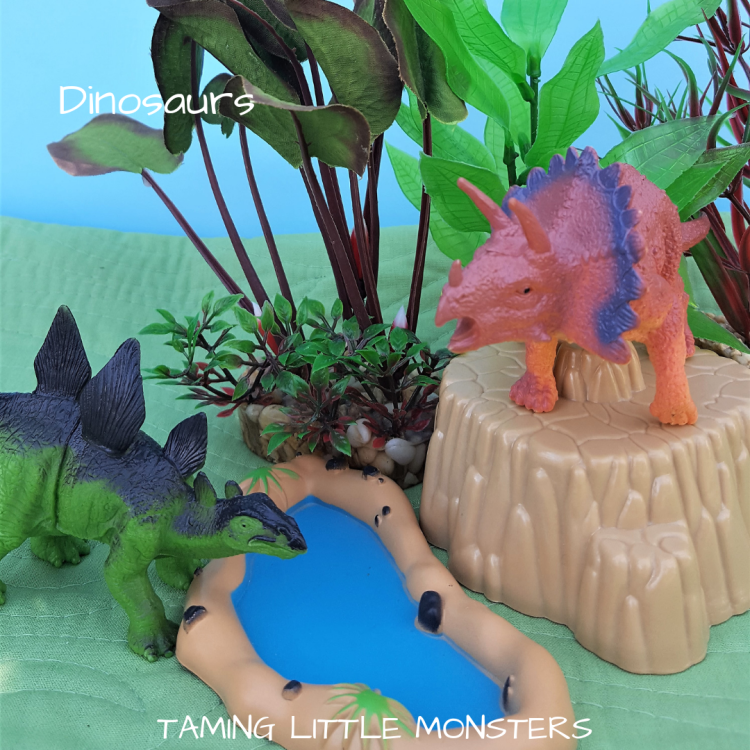
Have you tried having a dinosaur scavenger hunt in the backyard? Finding a dinosaur on top of the slide, or in the swing produces a lot of excited giggles.
Are you going to try small world play with your kids?
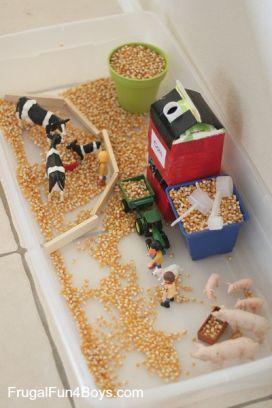

Farm sensory play from Frugal Fun for Boys and Girls
Contents: popping corn, recycled juice carton and cardboard box, wooden blocks
Tractor and farm small world play from Stay at Home Educator
Contents: felt, burlap, dyed rice, small recycled containers, rocks, mirror
* make your own pumpkins out of felt.
75+ Free (or Cheap) Outdoor Adventures
(+ a free summer adventure journal)
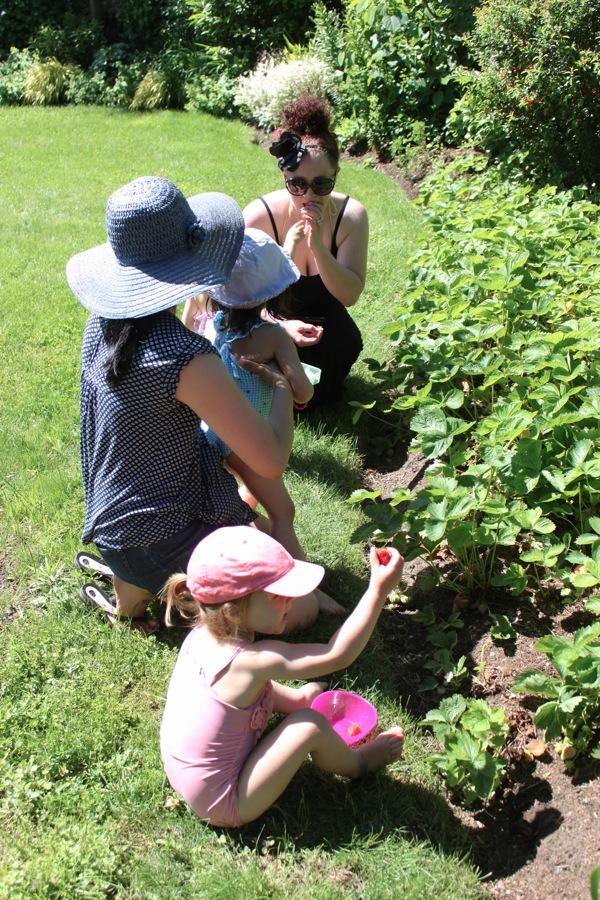

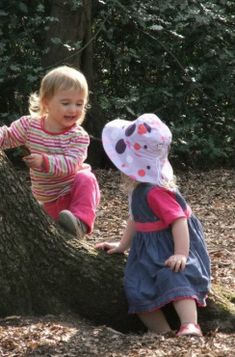
It was necessary for our family to come up with a list of free or cheap adventures kids can have this summer.
Summers can be exciting for kids, but for some parents (ahem), summers present a challenge. How do we keep our kids from getting bored and vegging out in front of a screen all day long?
One way our family has overcome this problem is by teaching our kids to live intentionally—teaching our kids to find the adventures in daily living.

Summer Adventure Journal:
Better yet, as our kids have new experiences, have them create a Summer Adventure Journal. This will be a place where they can write about and post photos and drawings of their experiences. By the end of the summer, not only will they have a keepsake journal for their memories, but the very act of creating the journal will help them to appreciate the simple pleasures of life.
Download the Summer Adventure Journal at the bottom of this article, and enjoy the list of summer adventure ideas below.
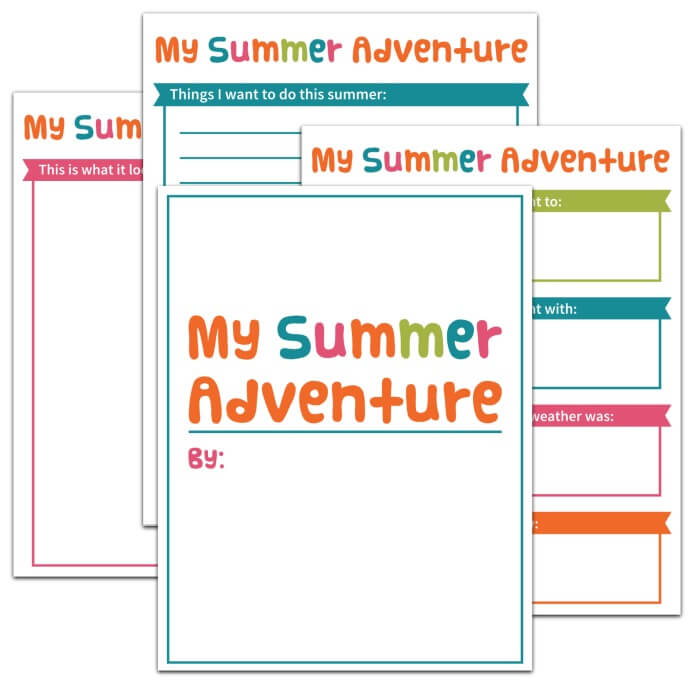
Free Or Cheap At-Home Adventures
Kids Can Have This Summer
1. Master an Outdoor Skill – Challenge your kids to master a new outdoor skill this summer: dribbling a basketball, jumping rope, playing bocce ball, throw a baseball, flying a kite, croquet, throwing a frisbee, etc. Have them note what skill they want to master at the beginning of the summer and then remind them to go outside as often as they can to learn.
2. Have a DIY Treat of the Week – Learn (right along with your kids) how to make DIY summer treats and make them together on a certain day each week: popsicles, homemade ice cream, sorbet, ice cream sandwiches, frozen drinks, soda floats, etc. Have your kids rate each treat so they can say which one is the best. Check out my Dessert Recipes for inspiration!
3. Play a Board Game of the Week – Start a family game night. Pick a new game every week. Have your kids keep a written record of who wins the most over the summer (in our house, that would be mom, she is master of the board games).
4. Start a Garden – It doesn’t have to be huge. Have your children pick just one or two vegetables or herbs they would like to grow this summer and pick a spot in your yard, flower bed, or large pots for these veggies to grow. Make sure you mark your calendar for days they need to go outside to weed, water, and tend their plants. Have your kids take pictures of each stage of their garden and the growth of their plants. Click here to read more about gardening.
5. Plan a Water Battle – Find as many squirt guns as you can and plan an epic battle in your yard. Get our the sprinkler for maximum wetness. Have your kids form teams and get the neighbor kids involved. Don’t forget to take pictures to remember the day.
6. Become a Missionary Kid Pen Pal – Find out what missionary families your church or denomination supports and find out if those families have kids. Have your kids write letter to those children to encourage them over the summer. Keep the returned letters in a folder for safe keeping.
7. Catch Bugs – Challenge your kids to catch one new species of bug every day for a couple weeks. Have them look up the bugs online or in a field guide. (It gets really fun during lightning bug season.) Have them take pictures of each bug they catch. Better yet — join in on our virtual summer science camp: Backyard Bugs! You and your kiddos will learn all sorts of fun facts about bugs.
8. Read Books to Earn Rewards – Contact your local library. Many of them have summer reading programs that earn kids rewards. Have your kids complete a Barnes & Noble reading journal (after they read 8 books), and they can earn a free book. Half Price Books also has a summer reading program where kids can earn “Bookworm Bucks.” Chuck E. Cheese’s offers $10 of free tokens to kids who read every day for two weeks. Keep a record of each book your child reads to show them how much they have read through the summer.
9. Create a Music Video – If you know a thing or two about video software, teach your kids to make their own music video to a song they all love.
10. Do a Crazy Car Wash – Get the kids into their swimsuits and go outside to wash the car. Getting soaked is a requirement.
11. Camp in the Yard – Pick a night or series of nights you plan to camp outside under the stars. Fill your evening and morning with fun outdoor activities like a campfire or outdoor games. Take photos of the experience to remember it.
12. Become a Screever – As Bert from Mary Poppins said, “Today I’m a screever, and as you can see, a screever’s an artist of highest degree.” A screever is an artist who draws pictures on sidewalks with colored chalk. Give your kids each a large section of your sidewalk or driveway and tell them it is their canvas to create the biggest, most elaborate drawing they can think of.
13. Make a Time Capsule – Have your kids think about 50 or 100 years into the future. What would they want people in that time to know about. Create a time capsule and bury it somewhere in your yard. Bonus points if they create a treasure map to find the capsule.
14. Stargaze – Pick a late night you’re going to keep the kids up to look for constellations. Sign up for the free online course that starts in June at Experience Astronomy. Use Stellarium to see what the constellations will look like in your local area the evening you plan to go out.
Free Or Cheap In-Town Adventures
Kids Can Have This Summer
15. Go on a Nature Walk – Take nature walk in your backyard or on a local trail in your area. Bring a camera to snap some photos of different objects (wildlife, plants, etc.) your kids can identify back at home. Look under rocks for small critters. Bring along a bird or insect field guide. Plan a “nature scavenger hunt”—type up a list of all the things you want your kids to find and have them look for those objects.
16. Family Bike Ride – Go on a regular bike ride with your kids, traveling a little further each time. Picks spots around your area, such as parks or historic landmarks, that make for fun or educational opportunities.
17. Eat Out for Free – Make a list of all the restaurants where kids eat free and plan on eating out a few times a month. Have your kids make a rating system for these restaurants and rate each one after you visit. Use MyKidsEatFree.com to find restaurants in your region.
18. Volunteer in Your Area – Use volunteermatch.com to find volunteer opportunities in your city.
19. Go on an Historic Homes Tour – Find some historic homes in your area and find out about tours they offer. Have your kids take photos of each home they see.
20. Go Geocaching – If you have a GPS (or smartphone with a GPS) your child can search for hidden “treasures” all over your area. It’s been called the world’s largest treasure hunt.
21. Take a Tour of Local Parks – Visit all the local parks in your area and have your kids tell you what they like about each one. Have them come up with a rating system for what makes for a good park and then have them give each park a “grade.”
22. Go to Vacation Bible School – Many churches put on VBS programs over the summer. Find the ones in your area and sign your kids up.
23. Go on a Picnic – Instead of a usual meal at home, find a local public area (or even your own backyard) and go on a picnic.
24. Visit the Cemetery – Sounds creepy, I know, but cemeteries can give your kids an appreciation for life and history. Have them do tombstone rubbings. Have a contest to see which kids can find the oldest grave, longest lifespan, shortest lifespan, graves with certain years on them, etc.
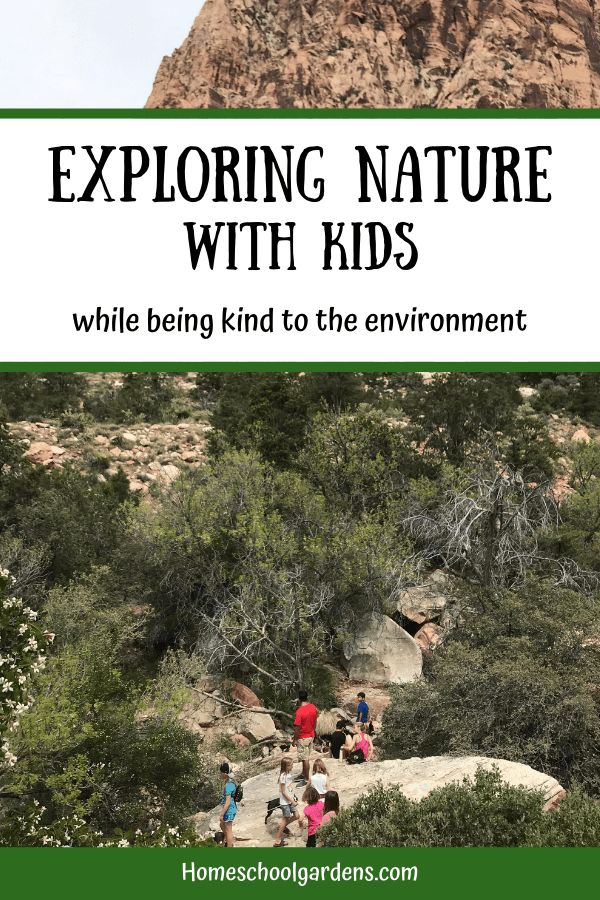
Free Or Cheap Short-Trip Adventures Kids Can Have This Summer
25. Participate in a Home Depot or Lowe’s DIY Workshops – Find a Home Depot or Lowe’s in your area and register for one of their kids’ workshops.
26. Do a Farmer’s Market Scavenger Hunt – Find a local farmer’s market and come up with a list of items you want to purchase. Turn your kids loose to find the cheapest of those items. Give a creative prize to the winner.
27. Go to a U-Pick Farm – Find a pick-your-own farm near you and find out when is the best time to pick locally grown produce and visit a u-pick farm. There are many places to pick strawberries, cherries, blueberries, blackberries, raspberries, peaces, figs, green beans, and even early apples in the summertime. Our favorites are strawberry and blueberry farms – the kids love to eat as they go. Remember to take photos of your kids and their harvest.
28. Go Garage Sale Hopping – Give each of your kids a $5 allowance (or whatever you want) and drive around to different garage sales looking for interesting treasures.
29. Learn How to Code – There are plenty of free coding games and websites out there that offer kids a taste of what coding is all about.
30. Build at the Lego Store – Find a Lego Store in your area and participate in one of their monthly mini builds. Quantities are limited so you’ll have to register online first.
31. Attend a Local Festival – Tens of thousands of festivals are going on each summer. Many of them are free. Find one near you.
32. Bowl for Free – Find a bowling ally in your area that participates in the Kids Bowl Free program. Kids get 2 free games of bowling every day all summer long.
33. Skate for Free – Find a skating rink in your area that participates in the Kids Skate Free program.
34. Enjoy Pottery Barn Story Time – Find a Pottery Barn in your area that has a weekly book club for readings, activities, and more.
35. Attend a Michaels Kids Camp – Michaels offers classes for kids. Find out what your local store does.
36. Attend a Salvation Army Youth Camp – Some of their youth camps are free. Others are relatively inexpensive. See what your local Salvation Army offers.
37. Attend a Bass Pro Shop Family Summer Camp – Many Bass Pro shops have free kids’ programs. Find a store in your area.
38. Go to Apple Camp – Apple stores have a “kids hour” when they teach kids how to make movies.
39. Go to a Cheap Summer Movie – Regal Cinemas, Cinemark, Ultra Star Cinemas, Megaplex Theatres, and Harkin Theatres have $1 family movies all summer long.
40. Go to the Drive-In – One of our kids favorite and most memorable summer activities is the drive-in movie. Get snacks ready and find a local double-feature in your area.
41. Visit a Ghost Town – Yes, ghost towns exist. You can find a list of ghost towns in your area by visiting GhostTowns.com. Before or after your visit, have your kids research online about the ghost town and its history.
42. Go to a 4H Fair – Take your kids to a local 4H fair. 4H is America’s largest youth development organization, and their local fairs are great places to learn about how animals are raised. Make sure to take plenty of photos of your kids with the animals.
43. Take Advantage of Free Days at the Zoo – Some zoos offer “free days” during the summer time. Take advantage of these opportunities. Or for a cheap alternative, buy a family zoo pass. Use this list of zoos and aquariums that participate in a nationwide reciprocal admissions program—so when you buy a family pass, you can get into other zoos around the country for free!
44. Visit a Local Nursery – Nurseries are great places to find out what plants are indigenous to your area and how you can best care for them. Call ahead and see if they offer tours.
Free Or Cheap Traveling Adventures
Kids Can Have This Summer
45. Visit a National Park – You can wait for a free entrance day, or if you have a 4th grader, your child and your whole family can take part in the Every Kid in a Park program (which is free). If you plan on frequenting these parks, look into buying an annual pass.
46. Take a Factory Tour – There are over 500 factories in the Unites States that give free tours. From airplane manufacturers to artist studios, from candy makers to ice cream manufacturers—there are many tours to choose from.
47. Go to a Free Target Event – If you live near a major city, you may be near a free Target event.
48. Visit the Beach – You might live near a beach, but for some of you, it will be a drive to get there. Bring sand castle building supplies and challenge your kids to build the best sand castle ever. Take a photo to remember the occasion.
49. American Girl Crafts and Parties – American Girl stores offer a variety of free programs, from craft events to tea parties.
50. Visit Your State Capital – Call ahead to see if they offer tours of your capital building or to see if you can meet with your local representative. Have your kids come up with a list of questions they want to ask the different people they might meet.
What other fun summer adventures kids can have this summer would you add to this list?
Did this list of free or cheap adventures kids can have this summer inspire you? Tell me about it in the comments! And don’t forget to download the Summer Journal (below)!
Help your kids document all their fun summer adventures!
Get the Summer Adventure Journal!
Join our community to receive the tools and advice you need to confidently educate your children with a Christian worldview.
More Resources on Kid Activities:
Simple Outdoor Play Series
There’s something so wonderful about creating a small world to play with.
Whether your child loves dolls, trains, dinosaurs or diggers, setting up a miniature land, where they can imagine, role play, chat and act our stories, is packed full of play and learning potential.
Here are fifteen of our favourite small world play ideas, and invitation for you to join in with us.

15 fabulous small world activities
What happens when we help children gather materials and set up a small world?
They stretch their imaginations and make up stories.
They develop language, learn and practise new words, and make conversations between characters.
They explore their senses and invent things with loose parts.
They might try out new situations or work on fears or challenges they are facing in real life.
They get to be the boss, in charge of their own mini world (which every child would love, right?!).
And we get a window into them, their minds and their passions, as we watch them direct the play and share what is important to them right now.
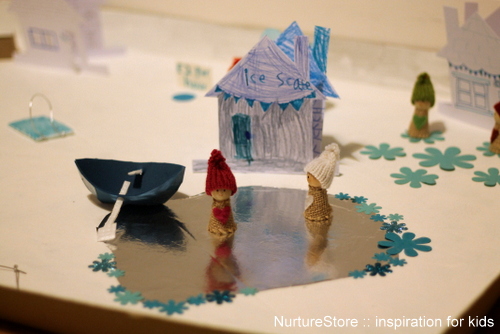
A small world is super simple to set up – or as elaborate as you care to make it.
Two dolls, two cups and a tea pot and you have a cafe ready to go.
Draw some roads on a piece of paper and add some cars and you’ve got a city.
But if you love crafting and making, you can go to town, adding all sorts of embellishments too.
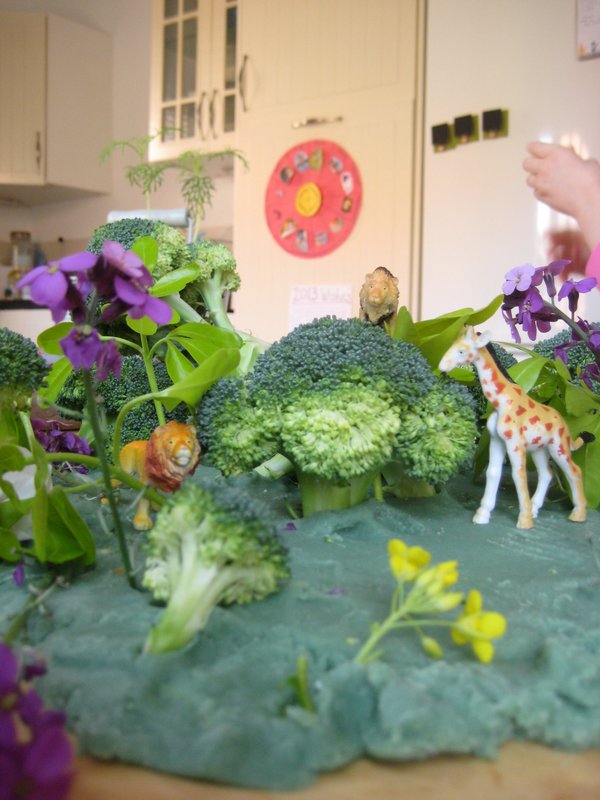
Young children get the most from small worlds which are familiar – where they can act out things they see in everyday life, or which bring a favourite story to life.
Older children might love to really stretch their imaginations and create magical lands and fantasy worlds.
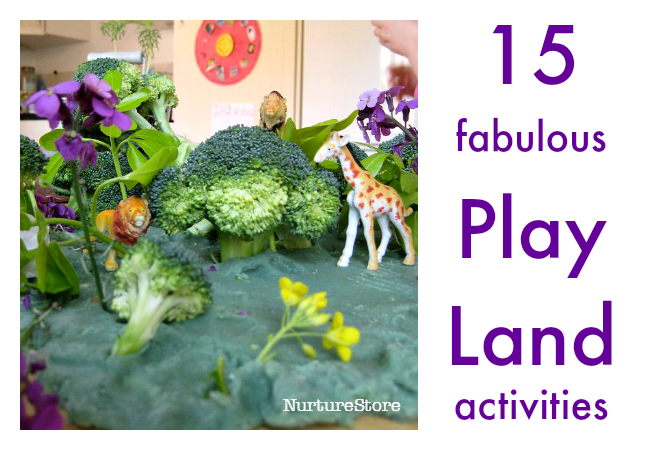
Favourite small worlds
You can make your small world seasonal, to match the world outdoors – like this winter wonderland. Or this spring farm.
Use loose parts to act out a favourite story – like Baba Yaga’s house in the forest, or the three bears’ den.
Make simple puppets, and host a tea party.
Or set up a sensory tub small world – like this sleepy bunny lavender tub.
Make a jungle with play dough, or make a jungle with a cardboard box.
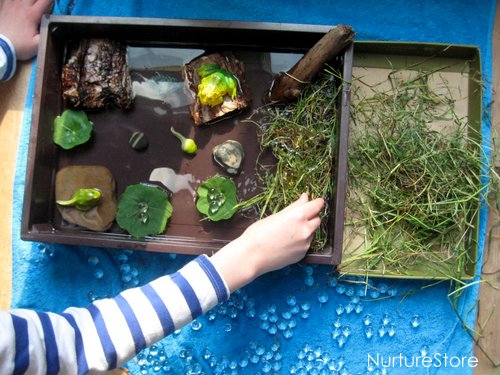
Paint a fairy land, set up a dragon world, or create a dinosaur home.
Use water to make a pond, or soil to make a farm.
Draw your own truck depot, or a cardboard box land.
Collecting and Crafting With Nature
Let’s Start With Collecting & Crafting Nature:
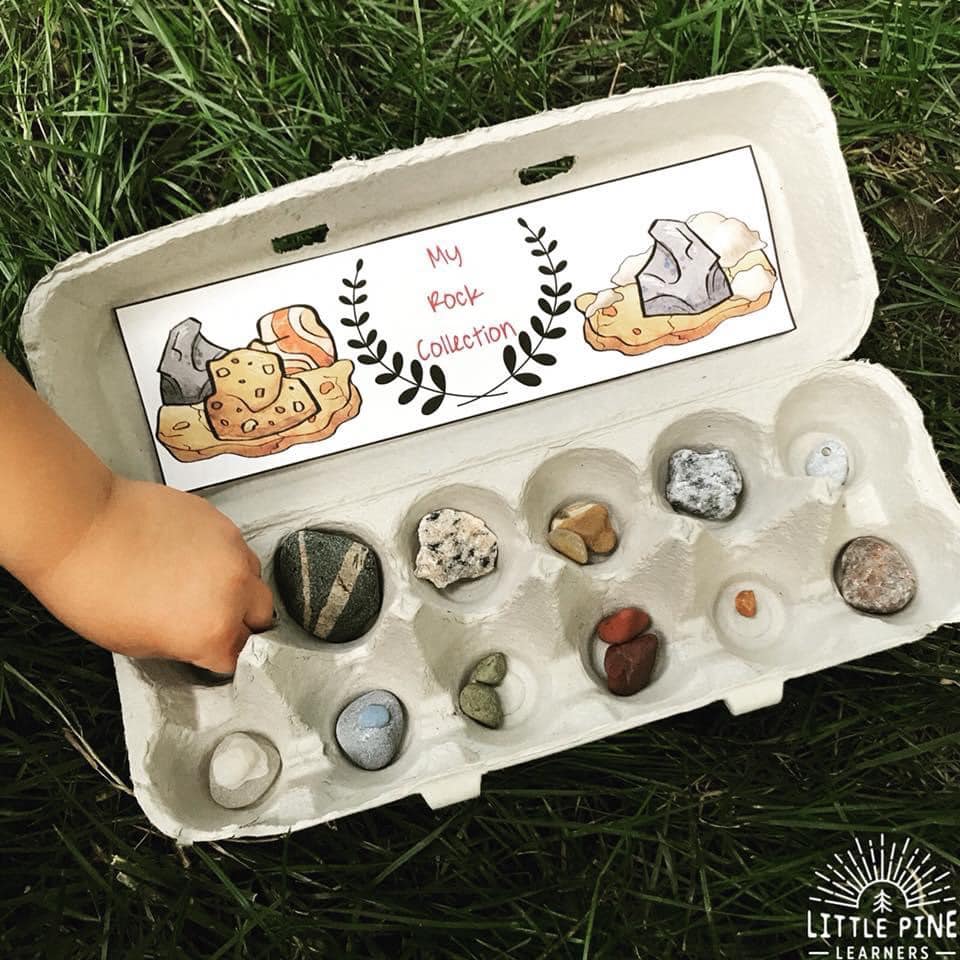
We love using egg cartons to collect nature finds! The separate compartments are perfect for collecting, sorting, and displaying your nature finds! If you are worried about salmonella, then I suggest getting a plastic egg carton so you can wash it.
Here’s a little more about the nature printables for the egg cartons:
These labels are a fun way to personalize and decorate your egg cartons! There are 7 different egg carton collection prompts: summer, fall, winter, spring, flowers, rocks, and one for general use. These can be used as a scavenger hunt or inspiration for items to collect during the nature walk. There is also a cover that says, “My Wild Finds” that goes on the top of the egg carton. These come in color and black/white. The black and white are great for coloring.
Here are a few photos of different labels. This is the top cover for the egg carton:
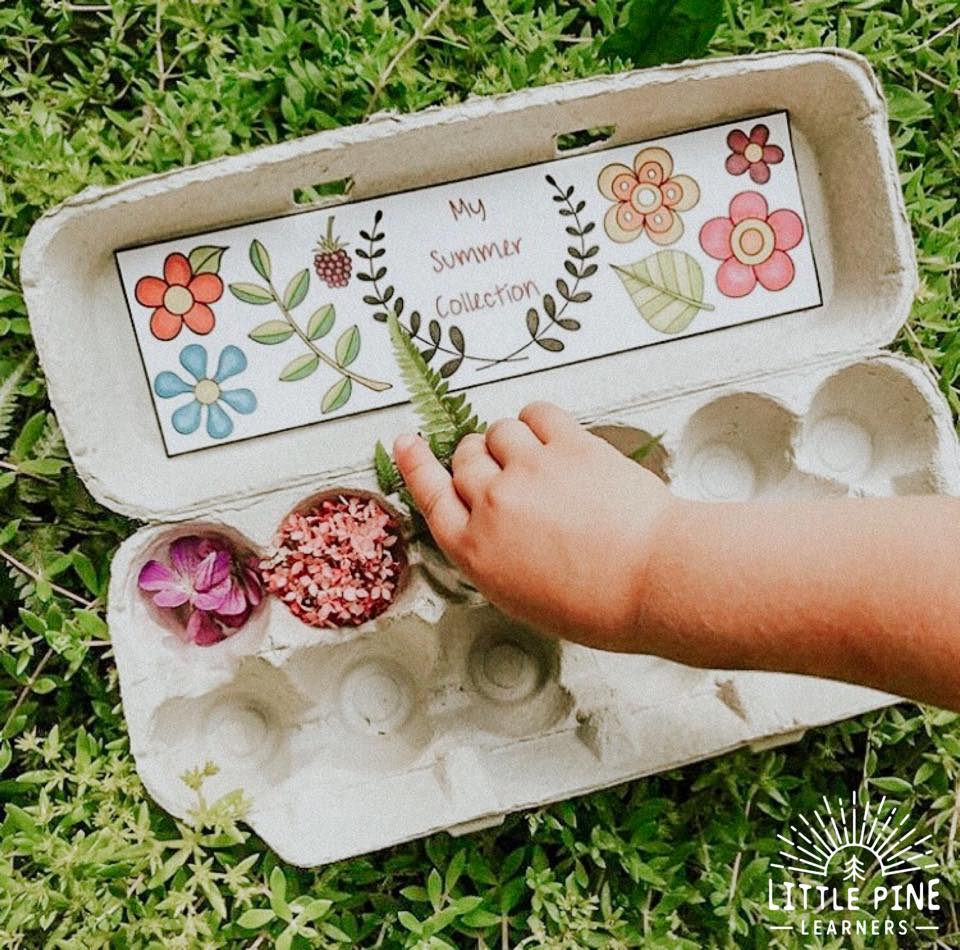
Here is the summer version. Bring your scissors outside and invite your little ones to strengthen their fine motor skills by cutting pieces of nature and putting them in the egg carton. There is so much variety in nature during the summer! We might need to try a larger egg carton this year.
You can see the rest of the labels in the preview in thisTeachers Pay Teachers store.
Once the items are collected, you can keep the collection together or decide to use pieces of it to create beautiful nature crowns, masks, and pictures!
Let’s check Out the Nature Crowns and Masks:
It’s so fun to see how the crafts change throughout the seasons. The crowns and masks look completely different from summer to fall due to the pieces of nature available to us. Check out this colorful and beautiful nature crown from the summer. The ferns and flowers make this crown look so regal! The nature printables for the crowns and masks make this activity so easy!

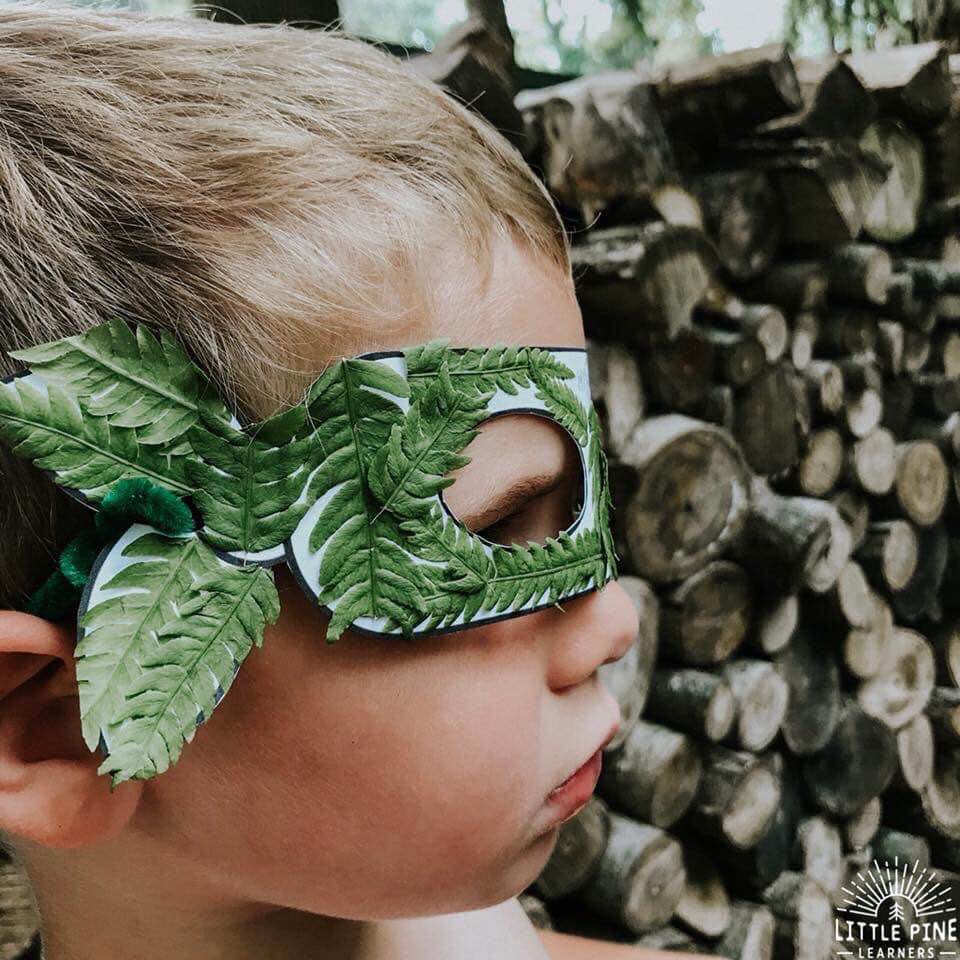
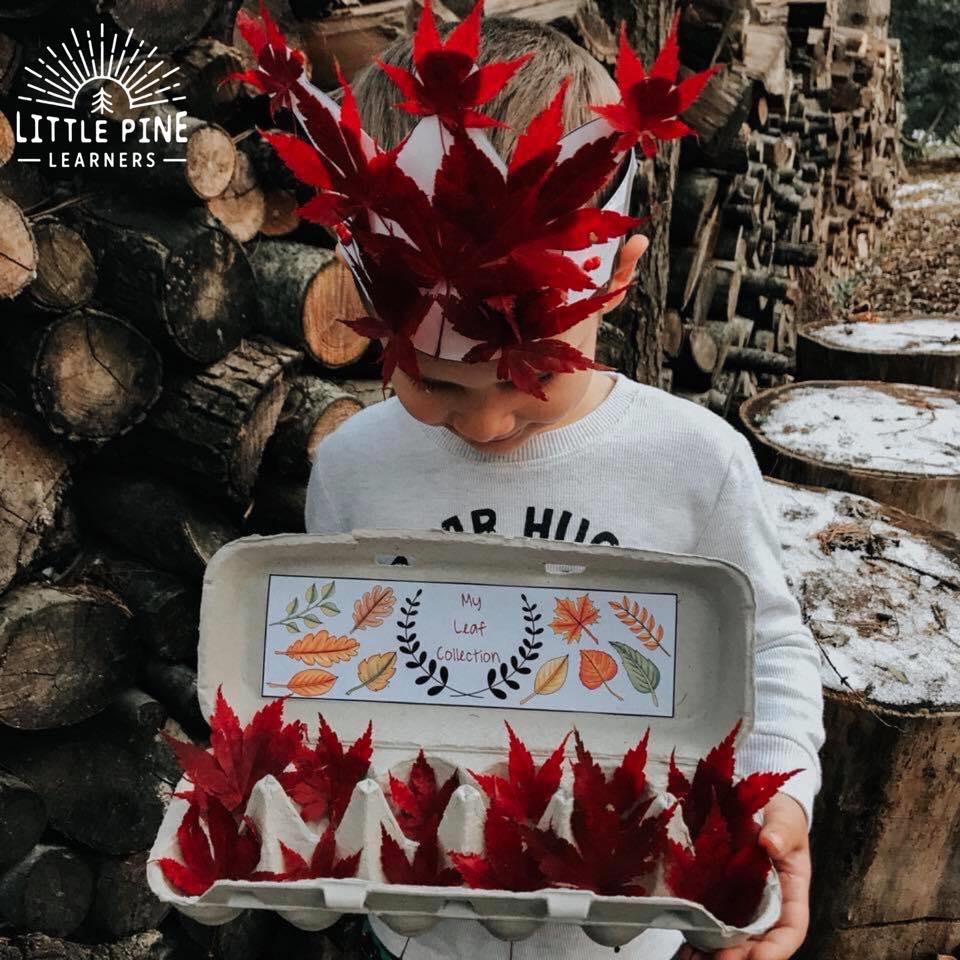
My son’s favorite color is green, so he loved the ferns. Next we made a “Teenage Mutant Ninja Turtle” mask. I love the fall crown too! We had a bunch of gorgeous Japanese Maple leaves that just fell from the tree so we put them to good use and glued them to the crown.
You can see the rest of the crown and mask designs here in the preview in my Teachers Pay Teachers store.
I Love How This Beautiful Nature Picture Turned Out! I also included a wide variety of nature printables to decorate with nature!
This bundle is great to get little ones enthused about playing and crafting with nature! It is also my first recommendation to the site Teachers Pay Teachers. Let me know what you think.
Living in the Rocky Mountains when Hope was little was such a gift. Whether we were wandering down the dirt roads in our neighborhood (checking out the roadside flowers and herbs), walking on a trail in a park, or exploring on Mt.Falcon: Hope lived every moment to the fullest when she was outside. I talked to her about all sorts of things along the way, even before she could speak back. She would point at things she wanted to explore close up. Back then everything outside was an exciting discovery of new treasures in the wild. I often took pictures of what interested her to show her dad when he got home. We both loved our walks together. As she got older she wanted to save things from her adventures. Here are a few ways to use those treasures in an artistic way.
Outdoor Sticky Mural

Nature is art, and you can also create your own custom art with elements from nature! I can Teach my Child has a lovely idea for an outdoor mural where toddlers can stick leaves, petals and whole flowers in any pattern of their choice. You’ll need contact paper for this activity, which you can stick to a wall or solid gate outside. Hand the children the materials and let them create art!
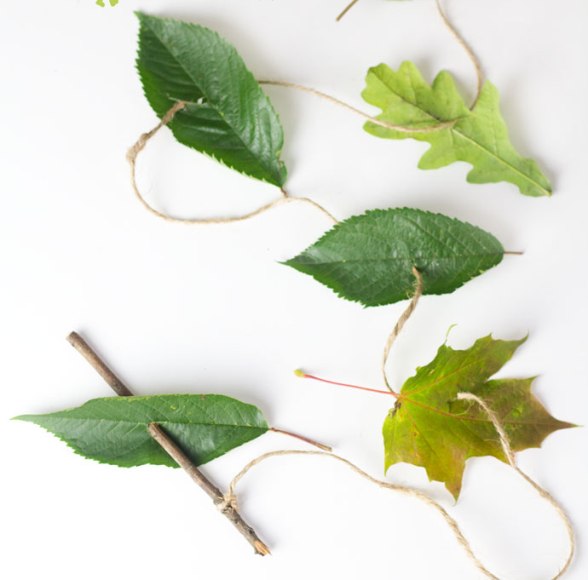
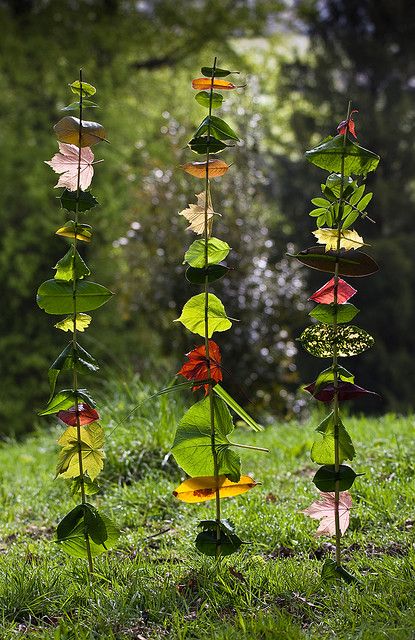
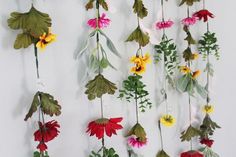
If you’ve tried threading beads with your little one, then this one is sure to be a hit! Kids Craft Room has a fun gross motor activity that involves 100% natural materials. Make a twig ‘needle’ if you don’t have a needle, tie on some twine ‘thread’ and you’re all set to thread your way through some flowers, herbs or leaves! This project has a Hungry Caterpillar feel to it, so reading the book along with this is a good idea.
***We often made mobiles from shorter strings of leaves or flowers. Or Hope hung some from a tree that her grandmother sat near. She had a hard time getting around so Hope strung all the different types of flowers from her yard. She hung them under a shady tree: that way my mom could see them all at once and they would last longer. When they started to get wilted Mom had me hang them in her room to dry.
Nature Sensory Bag
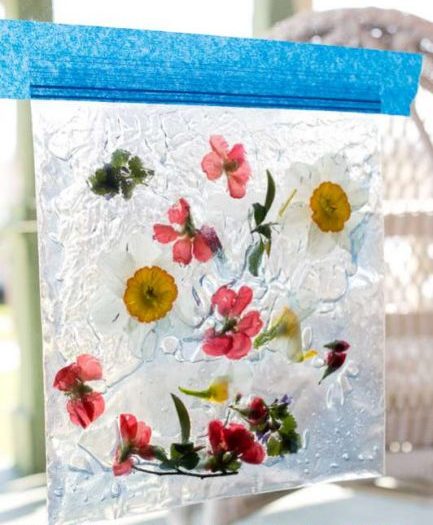
Sensory bags are a great way for babies to explore and learn to focus their attention. This sensory bag from Hands On as We Grow also doubles as a sun catcher – just stick it on the window! Gather the materials by doing a scavenger hunt or a nature walk and use double bags especially if you’re dealing with over-excited toddlers or babies! You can focus on using different textures here, so it’s more fun to squish and move around!
Botanical Sun Catchers
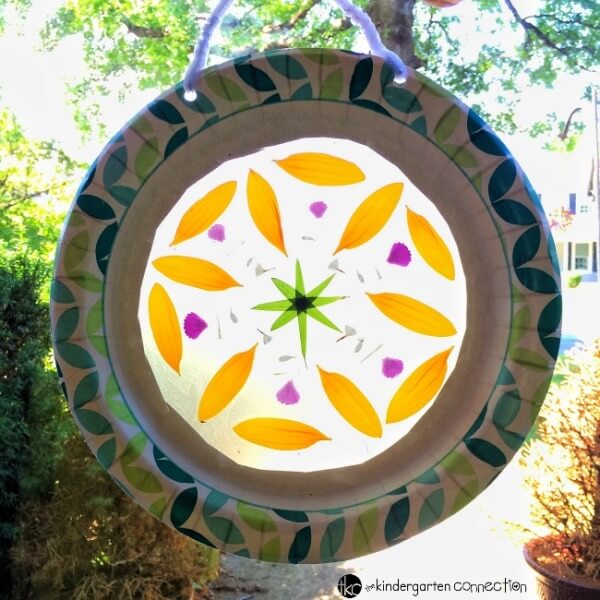
This activity from The Kindergarten Connection is more of a big-kid activity, but toddlers can do it with help from Mom or Dad. With paper plates, self adhesive transparent sheets and lots of pretty petals and leaves, you can create a beautiful sun catcher to hang by your window. What’s more, as the sun shines through the leaves, kids can clearly see the veins and other parts of the leaf and marvel at Nature’s attention to detail!
Hope's Favorite-Nature Sensory Bottles
The sensory input on this activity happens throughout the activity. Each individual nature sensory bottle is unique.
Begin with a trip outside to explore nature. Bring a plastic water bottle with you. Allow your child to really take the lead on this walk or hike. NOTE: If you are using an expensive bottle- hold onto the lid. The kiddos are sure to loose it!
If they find things that catch their eye, they can add them to their sensory bottle. They can either gather all of the items before and add them to the bottle later or they can add the items as they find them.
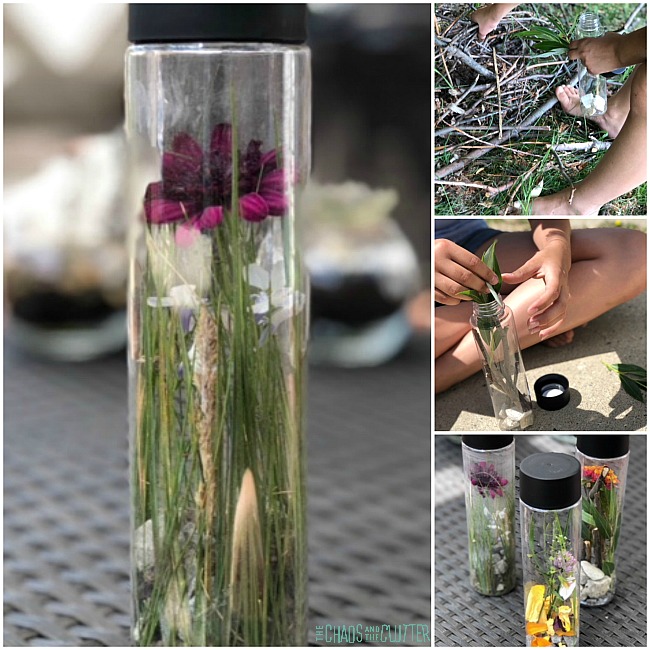
My kids really enjoyed creating their natural sensory bottles. They enjoyed climbing through the trees looking to discover items to include. I love how each one of them came out so differently and yet all were lovely. We filled ours in the spring and the colours were so beautiful. The flowers, flower petals, and purple clover contrasting against the white rocks, green leaves and stems, and brown twigs made them quite striking.
Nature Sensory Bottle
Materials needed:
empty unbreakable bottle (I used 1 liter clear soda bottles)
items found in nature
Instructions:
Go on a nature walk or hike to gather items for your nature sensory bottle. As you are outside, ask your child questions designed to help them become more aware of their sense.
“How does that rock feel?” or for younger kids, “Does that rock feel rough or smooth?”
“What do you smell?”
“Can you feel the wind?”
“What sounds do you hear?” or for younger kids, “Can you hear the birds chirping?”
“What colours or shapes do you see?”
As they gather items to fill their bottle, have them describe the items to you. See if they can incorporate their senses into the descriptions. Really, any item they find can be added to the sensory bottle, so this list is not comprehensive.
When complete, place the lid on the bottle. Some of the items in these sensory bottles can mould over time due to moisture, so the bottles only keep for a few weeks. Or you can fill the bottle up and empty it right away and head back out on another nature hike to fill it again.
What to put in a nature sensory bottle:
sticks
rocks
pussy willows
leaves
snow
water
flowers
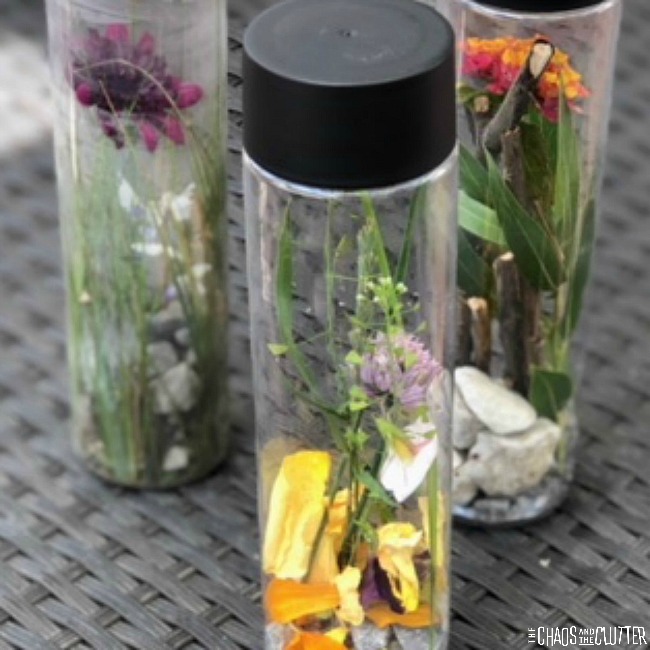
flower petals
weeds
pebbles
seeds
dirt
mud
sea shells
pine cones
pine needles
feathers
herbs
grass
acorns
sand
berries
insects (only if you poke holes in the bottle of course)
wheat
You can do this sensory activity in any season. Encourage interest in the different colors and textures as the opportunity arises. The nice thing about that is that the natural sensory bottle you make in winter will be very different from the one you make in spring. My favourite season is fall because of the colours of the leaves. They make beautiful sensory bottles!
Nature Portraits

Does your toddler like making faces? Well, then this activity from the Resourceful Mama is perfect for her! With paper plates and lots of leaves, flowers, berries and more, you and your toddler can make some hilarious looking faces! Gather twine or long grass for hair and go crazy with some weird hair styles! Just hand the materials to your little one and let her create a face to her liking.
Nature Collage
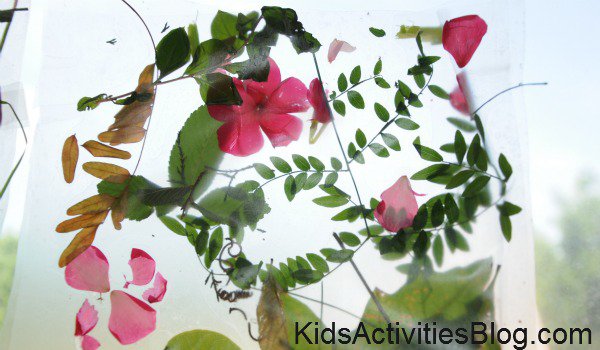
Collages are among the easiest craft projects for toddlers and preschoolers, and this one from Kids Activities Blog is no different! However, what’s special here is that you use only natural elements to make the collage! They have used contact paper to make the collage do double duty as a sun catcher, but you can just use a sheet of thick paper or card stock as well. Use fresh flowers or dried ones – they’ll all look pretty!
Turn a Family Scavenger Hunt into a Nature Mobile Fall Craft for Kids09/30/2014 BY NICOLE ETOLEN
Today we have a fun nature mobile fall craft for kids that doubles as a great way to get your family active. Strap on your hiking shoes and get ready to forage through the wilds to get the supplies for this easy craft! Winter is on its way, my friends. There is no denying it. The temperatures are dipping and some of us have to turn on our heat at night! Soak up the last of the warm remnants of summer and spend some time outdoors before the icy temps hit. While you’re out there, keep an eye out for some great supplies in nature for this craft!
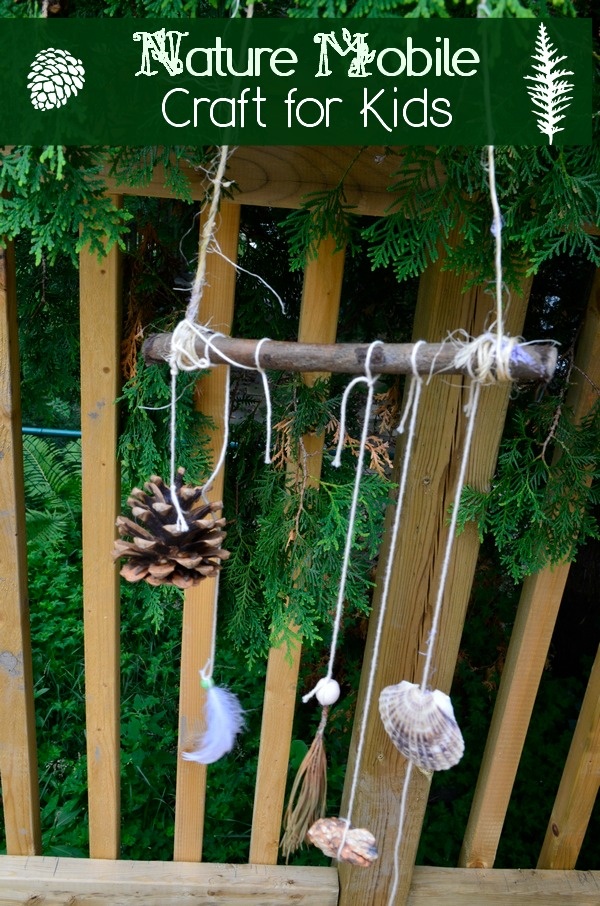
WHAT YOU’LL NEED:
Pinecones, seashells, feathers, cool rocks and any other natural elements that you find on your journey.
Twine or other natural-looking rope
Beads, if desired, preferably in browns, greens and other forest colors.
A thick stick or twig
SUPPLIES FOR CITY DWELLERS
Live in the city and can’t get to nature? We don’t want to leave you out! You can find most of the supplies at a craft store. Take a look at our suggestions.
HOW TO MAKE IT:
Start by gathering your supplies for this fall craft for kids. This is the really fun part! If you live in a woodsy area, you could find everything you need in your own front yard. For the seashells, dig into your family memory box from past trips to the shore. Don’t have seashells? No big deal, you can really use any natural elements here. The key is to make it meaningful to your family.
Lay everything out in front of you so you can see what you have. Take the thick twig and place it at the top of your surface. Arrange your other elements until you have everything where you want it.
Cut your twine in varying lengths, enough pieces for each item.
4. Use the twine- and beads, if desired- to attach each piece to the
thick stick.
5. Create a hanger by tying the twine to each ends of the stick, with enough give in the middle to let it dangle from your hook.
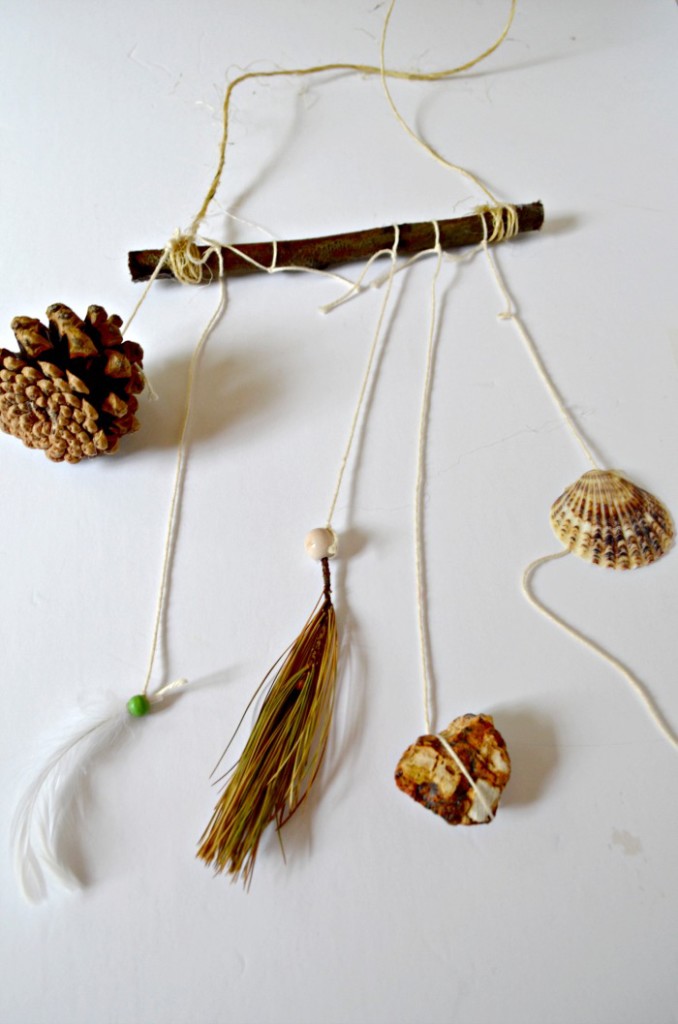
6. Hang your nature mobile someplace where everyone can admire it!
That’s it! Easy, right? You could take this nature mobile fall craft for kids in so many different directions. Make one each season and bring it out to celebrate the change in weather. Make it a new tradition: when you go on vacation, search for items for another mobile. The great thing about this fall craft for kids is that it has the potential to bring the entire family together.
DIY Pressed Nature Suncatcher Craft for Kids
This activity was inspired by our DIY Nature Slides for the light table. It uses simple materials and not only teaches kids about the environment in their area but it’s also a fun activity to work on fine motor skills.
Materials:
Flowers/leaves from your yard or local park
Laminator
Laminating pouches
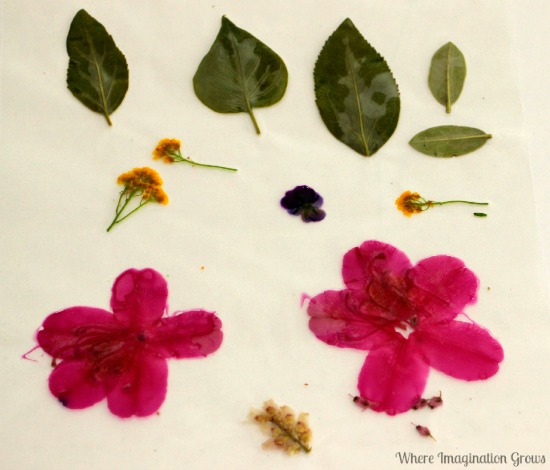
String
Scissors
Hole punch
Tape or suction cups
Start this activity outside by collecting flowers and leaves from your yard or local park. My daughter calls this part a “nature adventure” as we take magnifying glasses and bag for our finds with us and walk around the neighborhood. It’s a great way to begin discussions about local plant life and the life cycle of plants.
Once we collected a few different types of flowers and leaves we took them home and laminated them.
For this activity, we just laid the flowers on the laminating pouches and ra, cut off the excess stems, and sent them through the laminator. If you have more time I’d recommend pressing the flowers first but my daughter didn’t want to wait a week or two to see her nature suncatchers so we just did them as is.
Wax Paper Pressing Method
One of the most common ways to preserve leaves is by pressing them between wax paper.

What You Need:
Leaves
Wax paper
Thin towel or paper
Iron
Ironing board
What You Do:
Place some leaves or flowers or between two pieces of wax paper.
Put a towel or a piece of thick paper over the wax paper.
Press on the towel or paper with a warm iron to seal the wax sheets together. This takes about 2-5 minutes on each side, depending on how moist the leaf is. Once you have finished one side, flip the leaf over and do the other side.
Cut around the leaf, leaving a small margin of wax paper to ensure that it will stay sealed.
Rather than cutting out the leaves, you may want to try to peel the wax paper off the leaves, leaving a coat of wax behind to protect the leaves. Try this on one leaf first to see if this method works for you.
I love shadow boxes so this is one that I love.
We have been collecting shoe box lids for a variety of activities and this one came straight from the wonderful artistic ideas shared by Casa Maria’s Creative Learning Zone….
Prepare the Shadow Box
To make these beautiful shadow boxes, the children started by pouring glue into shoebox lids. I wasn’t sure how much Mod-Podge would be needed so I had them at least fill the lid with enough glue that the nature items could lay firmly in the Mod-podge…

Collect Items in Nature
Next, the children went outside to collect nature items to put in their mod-podge. I had the children go back and forth to collect something and instructed them to look for something different each time so they would have a variety of items to put in the glue…
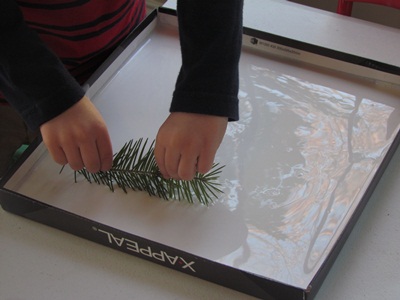
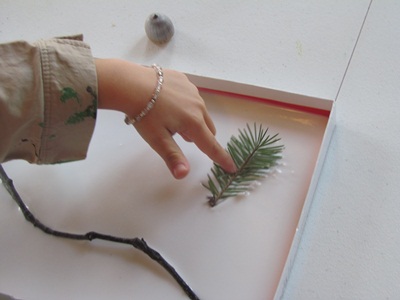
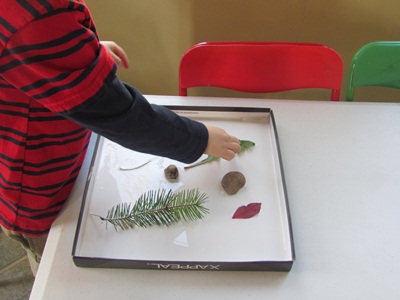
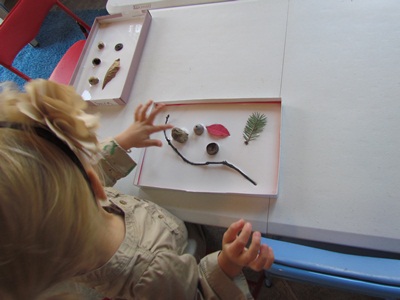
The children found leaves, sticks, pine needles, acorns, flowers, rocks, and a few other nature items to add to their boxes…
I encouraged the children to be very selective as they searched for items to add to their shadow boxes. For past activities, the children would grab a handful of random leaves and give little thought as to the beauty or different qualities of each item they bring in. So this time, I wanted to slow them down and have them be more thoughtful in what they selected to add to their boxes…
Design the Shadow Box
Some of the children were very selective as to where they set their nature items in the box. That would be my Hopey, wanting color balance and symmetry. Other children just placed them anywhere in the box…
Add a Colorful Effect
Once the children added a nice supply of nature items to their box lids, then we began to add some color. I debated about leaving the glue just white because I felt like they were beautiful as they were but the children loved this next step so I am glad we continued on….
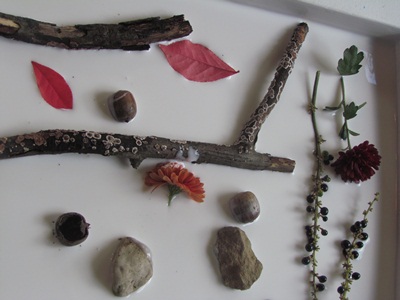
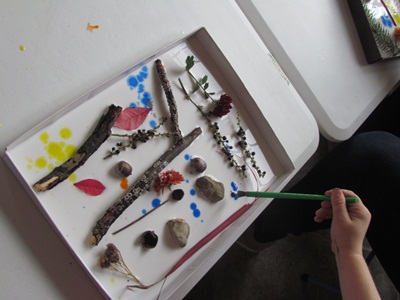
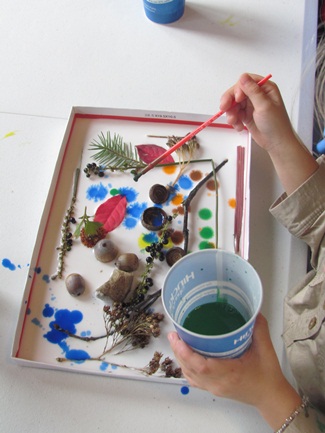
For our next step, I set out cups of slightly watered down tempera paint and some paint brushes. The children used the brushes to gently sprinkle different colors of paint on the glue (or white spaces between their nature items)…
Enjoy the Creative Process
The children concentrated on adding color. The room was so quiet as the children focused on the process for about 10 whole minutes which is unusual in my classroom…
Once each child was satisfied with the paint dripping part of this process, then I set the shadow boxes up to dry for a few days….
Embrace the Unique Creations
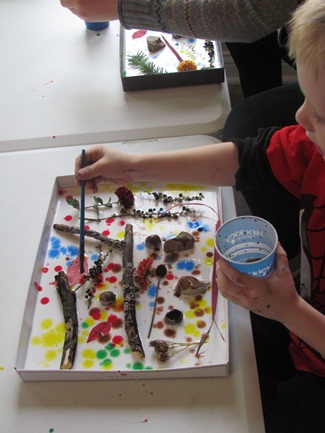
The shadow boxes have been drying for over a week so far.. Ours are still not quite dry but as they dry, the glue starts to turn clear. I hung these up for a quick photo and had to take them back down because the glue was dripping. The shadow box all the way to the left is almost completely dry – as you can see the glue has started to turn clear in color. I am interested to see the final results of their unique creations and the nature items should really stand out…
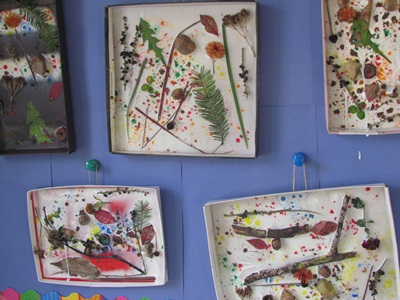
Hope really liked the effect of spraying water with a spray bottle over the whole shadow box -allowing the watercolor to spread out under and around her treasures.
200+ Outdoor Seasonal Activities
50 Ideas for Your Summer Outdoor Bucket List
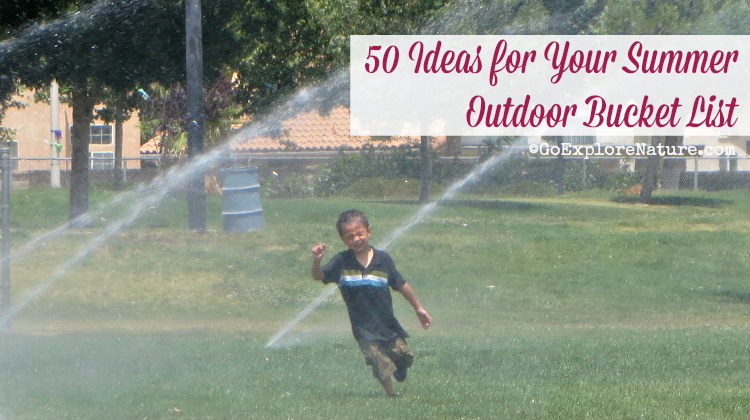
At the start of every season, we create an outdoor fun list. Together, we dream up some things we’d like to do, write those ideas down and then try to make them happen. Some of the ideas on our summer outdoor bucket list are simple, but others require more time – things like cherry picking or fishing. Of course, more than any other time of year, we also plan for lots of downtime to make room in our lives for enjoying summer’s simple pleasures.
Instead of sharing what’s on our family’s summer outdoor bucket list this year (you can see our 2010 and 2012 lists for past examples), I thought I’d share some ideas to help you make your own. These 50 ideas for your summer outdoor bucket list should keep the kids entertained and inspired all season long.
20 Things to Do in Your Backyard
Build a backyard weather station
Create a chalk garden
Create a mobile backyard beach
Design a fairy garden
Do some backyard bird watching
Go on a summer nature scavenger hunt
Have a backyard campout
Host an outdoor tea party
Host a backyard movie night
Hunt for backyard critters
Make a nature play station
Play with mud: Make mud cakes or mud prints, try mud painting or a enjoy a backyard mud bath
Set up a playhouse, fort, cardboard box or other kid’s-only space
Take a glow stick walk
Throw water balloons or have a water balloon toss
10 Ways to Explore in Your Community
Explore a new-to-you neighborhood park
Go on a field trip to a local natural history museum, science center, nature center or other museum
Hunt for a geocache
Make drip castles at the beach
Visit a state or national park
10 Nature crafts
Create with clay and natural materials
Design your own fairy house
Keep a summer adventure journal
Light up your space with recycled bottle lanterns
Make nature bracelets
Recycle a toilet paper roll into a bird or a bird feeder
Run with wind streamers
5 Summer Science Experiments
Create an outdoor LEGO solar system
Grow crystals
Perform water balloon splatter tests
5 Tastes of Summer
Enjoy a summer BBQ
Picnic in the park
Roast s’mores over a backyard campfire
Savor a sno-cone
5 Summer Science Experiments

Science and nature go together like peas in a pod, especially at our house. Around here, common reading for The Big Explorer (9) includes books about extreme weather and space, and The Little Explorer (6) is currently working his way through the complete Magic School Bus books, which are aptly called “science chapter books.” Which is all to say that you can bet there will be … [Read more...]
Fun Friday: Run Through the Sprinklers
Little Makers and Explorers
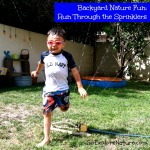
It is hot here is Southern California. Like 90+ degrees Fahrenheit hot. Which makes going to school uncomfortable and spending time outside afterward just plain torture.Unless there’s water involved.Running through the sprinklers is one of our favorite ways to play with water in the backyard. We don’t even both to turn on our sprinklers; we simply add a sprinkler attachment to … [Read more...]
Fun Friday: Make a Mud Pie
Little Makers and Explorers
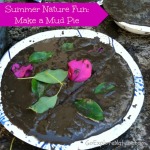
August in our neck of the woods is usually when the heat starts to turns up. At times like this, it helps to have some ideas for water play in the backyard on hand. One of our favorites: Mixing water and dirt to make a mud pie. To make a mud pie, you will need: Dirt Water Something to use to mix the dirt & water together, like a stick or a plastic … [Read more...]
10 Ways to Explore Nature at Night
Little Makers and Explorers

Summer is full of warm days that blend right into slightly cooler evenings – most of which are perfect for being outside. Combine that with less pressure to get the kids to bed at a certain time and you’ve got a winning combination. Time to head outside and explore! A few tips for exploring nature at night with kids: Keep it short and simple. Since our kids are usually … [Read more...]
Fun Friday: Gaze at the Stars
Little Makers and Explorers

We’ve talked about stargazing around here before, but that was during the heart of winter. There’s something even more magical about staring up at the nighttime sky during the summer. Sure, you’ll have to stay up extra late to gaze at the stars. But who cares – that’s what summers were made for, right? Photo by Jonas Wiklund When kids are young, gazing at … [Read more...]
Time to Create: Nature Weaving
Little Makers and Explorers
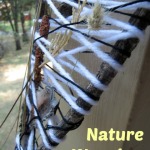
During our recent two-week stint in Yosemite, The Explorers and I did a whole lot of nothing. Sweet, sweet nothing. Which isn’t to say we weren’t connecting with nature; quite the opposite, actually. Case in point: Over the course of several days, we took to gathering natural bits from the area around our cabin for a little project: Nature weaving. To weave on a branch, … [Read more...]
10 Ideas for Water Play in the Backyard
Little Makers and Explorers
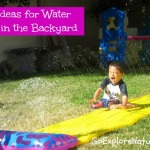
We’ve been talking about water play a lot this month, what with it being summer and all. And while spending a morning or afternoon at the beach or river is wonderful, sometimes schedules just don’t permit it. No worries! There are plenty of ways to enjoy water play right in your own backyard. Know how to stay cool outside on hot days and always keep an eye on all kids … [Read more...]
Fun Friday: Make Fresh-Squeezed Lemonade
Little Makers and Explorers
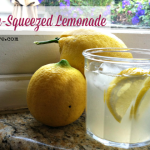
I think this is a first for me – sharing an idea from the kitchen, that is. This one all started when a certain someone began picking fresh lemons off the tree in our backyard. “To make lemon juice,” he said. We quickly realized The Little Explorer was on to something. What better way to kick off summer, really, than to make fresh-squeezed lemonade? Making fresh-squeezed … [Read more...]
Give a Kid a Camera: Rocks
Little Makers and Explorers
Give A Kid a Camera is a monthly series highlighting recent submissions to the Flickr pool. Come show us what nature looks like through the eyes of your explorer(s). July’s Inspiration: RocksA 12-year-old's rock collection by JaneSJEBeach rock by Abbey’s World (Audrey, age 2)August’s Challenge: Summer Moments in NatureIs it just me or has summer flown by? It’s time to ask your … [Read more...]
Fun Friday: Rock Necklaces
Little Makers and Explorers
Fun Friday activities are quick-and-simple ways to explore nature in your own backyard. Am I the only feeling like summer is all about crafting? We’ve been craft crazy these past few weeks! One of the biggest hits so far has been our rock necklaces. (In fact, we received tons of compliments on our creations when we were in Yosemite!)Inspired by this idea I spotted in a recent … [Read more...]
How to Tour Tide Pools With Kids
Little Makers and Explorers
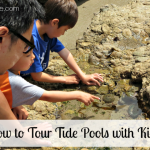
Visiting the beach is one of our family’s favorite things to do in L.A. If we happen to time our visit for when tide pools are accessible, even better. That’s when we get a chance to see all kinds of sea life right at the water’s edge! If you’re not familiar with tide pools yet, let me back up. Tide pools form twice a day during low tide (when the tide retreats from the … [Read more...]
DIY Animal Photo Book
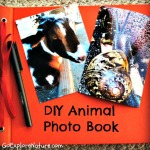
When The Big Explorer started kindergarten some four years back, we created a nature ABC book. It was a simple way to combine his growing interest in letters and words with the time we spent outside in nature.With The Little Explorer set to start kindergarten himself this fall, we’ve been talking about what kind of book he wanted to make. His choice? An animal photo book using … [Read more...]
How to Stay Cool Outside on Hot Days

Kids playing outside and summer go together like birds of a feather, right? Not necessarily, says a new report from the National Wildlife Federation.In fact, weather (both cold and hot) is the No. 1 reason parents cited for not letting kids play outside. (See the full report at The Forecast Calls for Play.) That’s pretty powerful stuff.There’s reason to be concerned when the
Great American Backyard Campout
Little Makers and Explorers

The Great American Backyard Campout is a one-night event held across the nation to encourage kids of all generations to connect with nature. It’s free to participate and all you need to do to get started is fill out the Pledge to Campout for Wildlife. You can camp out with just your family, invite friends along or join a team in your community. You can even participate if you camp on a different night.
Get ready!
I’m guessing you first-timers might be a little worried about taking the babes camping. “What equipment do I need?” “Will the kids actually sleep?” “Will we?” “What will we do all evening?” Relax! I’ve got you covered!

We’ve camped out in our backyard three summers in a row and I’m here to tell you it can be done! It can even be fun! Here are a few things I’ve written that I hope can help:
The Down & Dirty Guide to Camping With Kids by Helen Olsson
Plus, more tips from around the web for camping with kids in the backyard & beyond!
The NWF is also here to help. Check out its Get Ready for the Great American Backyard Campout page, which provides camping tips, songs and stories, camping recipes, even ideas for games and activities.
So no more excuses – this is the summer you’re going to do it! And seasoned campers, why not invite some newbies to join you on your next camping adventure?
50 Ideas for Your Fall Outdoor Bucket List
Little Makers and Explorers
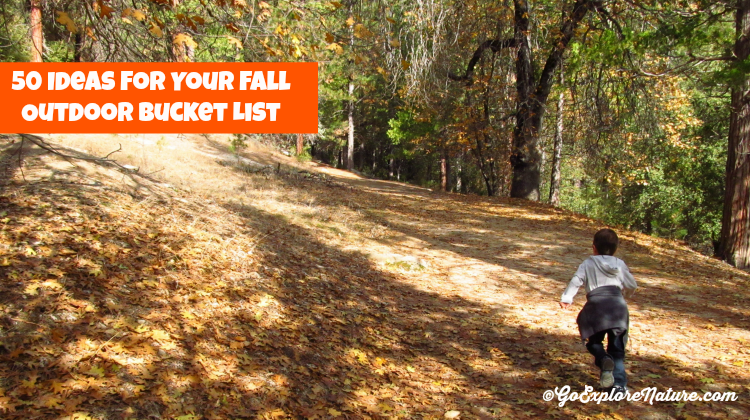
Here are 50 ideas for your fall bucket list. When it comes to seasons, fall seems to get the short end of the stick. After all, it arrives on the heels of our beloved summer, which never seems to last long enough.
But around here, fall is full of its own treasures. Pumpkin patches, apple cider, puddle jumping, trick-or-treating, nature crafts, cool-weather hikes, birthday celebrations, Thanksgiving, the countdown to Christmas and more.
For me, fall represents family traditions, so I look forward to it each year. One of our traditions is creating an outdoor bucket list. Some items on our list stay the same from year to year; others are entirely new. (You can see the lists we made back in 2010 and 2012 if you want.)
If you’d like to make your own fall outdoor bucket list, you’ve come to the right place. Here are a few fun and festive ways your family can connect with nature this fall.
10 Things to Do in Your Backyard
Go puddle jumping
Host a snail race
Jump or run through a pile of leaves
Go on a spider web hunt
Plant a fall garden
Go on a leaf hunt
Make bark rubbings
Create land art
Go bug hunting
Play I Spy Crows
5 Ideas for Fall Nature Walks and Scavenger Hunts
Take a flashlight walk
Go for a walk in the rain
Take a thankfulness walk
5 Fall Nature Crafts
Make leaf prints
Make a thankfulness tree
Create rain art
Make a leaf crown
Design your own leaf placemat
10 Activities to Try in Your Community
See fall foliage
Drink fresh apple cider
Go to a harvest festival
Navigate your way through a corn maze
Visit a farmers’ market
Go on a fall camping trip
Visit a farm, zoo or wildlife rescue center
Take a field trip in nature to a place of your choosing
10 Halloween Nature Activities
Make a snack-o-lantern for the birds
Go on a Halloween nature scavenger hunt
Create a pet rock cemetery
Go on a pumpkin counting walk
Make your own scarecrow
Roast pumpkin seeds
Decorate and/or carve pumpkins
Make a pumpkin planter
Watch a pumpkin rot
Fall Nature Photo Scavenger Hunt: Signs of Fall
Little Makers and Explorers

Here’s what fall looks like around these parts at the moment. Yeah, I know, tough life. The summer-like weather does make it easy to spend time outside (at least, during the cooler part of the days). But it doesn’t help much for those of us eager to welcome in the new season and all of its unique gifts. That’s where the Fall Nature Photo Scavenger Hunt comes in … [Read more...]
Your Fall Guide to Exploring Nature
Little Makers and Explorers

Around these parts, fall is all about The Big Explorer’s birthday (he turns 8 next week – gasp!), Halloween, Thanksgiving and getting ready for the biggest holiday of them all in December. It’s a time full of crisp evenings, yummy foods and general mass excitement. The catch for us during all this fun is finding time to slow down, head outside, connect with each other and … [Read more...]
Fall Nature Photo Scavenger Hunt
Little Makers and Explorers
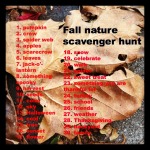
Several months ago, I created a get outside photo scavenger hunt that a lot of you seemed to enjoy. I thought it might be fun to try another one – this time to celebrate fall.The only rule for the fall nature photo scavenger hunt is that there are no rules. I’ve come up with some prompts to inspire you, but exactly what you photograph and when is entirely up to you. (Hopefully, … [Read more...]
Our Fall Fun List
Little Makers and Explorers
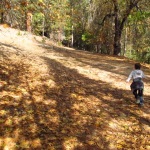
Backyard Nature Fun
Make a scarecrow
Create a pumpkin planter
Decorate or carve a pumpkin
Roast pumpkin seeds
Bake an apple and/or pumpkin pie
Host a snail race (if we can find some critter contestants!)
Go trick-or-treating
Set up a backyard weather station
Build a fort
Enjoy a backyard campfire
Bake holiday cookies
50 Ways to Connect with Nature This Winter
(With or Without Snow)
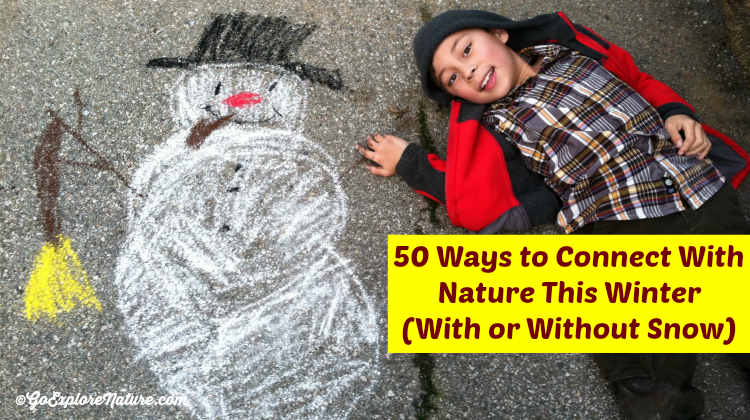
In a perfect world, getting outside would be as easy as heading out your back door and following your kids’ lead. But for those days when you need a little more inspiration, here are a slew of ways to connect with nature this winter – with or without snow. And don’t forget that on the worst of days, there are plenty of ways you can connect with nature inside, too.
20 Things to Do in Your Backyard
Go on a winter picnic
Build a backyard weather station
Start a family adventure journal
Dig in the dirt
Have a cloud race
Climb a tree
Make a pinecone bird feeder
Go on a backyard bug hunt
Keep a moon diary
Start a rock collection
Explore a tree
Go stargazing
Stack rocks
Find north with a stick
Participate in the Great Backyard Bird Count
Build a stick tower
Design your own chalk garden
Play the listening game
Walk to school
Watch a sunset
5 Ideas for Nature Walks & Scavenger Hunts
Go on a winter nature photo hunt
Take a color walk
Go on a micro safari
Take a winter nature walk
Go on a nature art walk
5 Winter Nature Crafts
Make nature wands
Create ice art
Make wind streamers
Try a Valentine nature craft
Make a recycled nature rattle
20 Ways to Connect with Nature in the Snow
Explore snowflakes
Make a snow sculpture bird feeder
Build a snow fort
Make a snow castle with sand toys
Hunt for heart reflectors
Track animals in the snow
Paint snow angels
Turn your mud pie kitchen into a snow kitchen
Try backyard snowshoeing
Go icicle hunting
Build snow animals
Turn fresh snow into an icy treat
Enjoy a snow picnic
Design a snowy treasure hunt
Make snow track pictures
Catch a snowflake on your tongue
Make your own snow sculpture
Create a snow maze
Have a snowball fight
Go sledding or tubing
30 Ideas for Winter Backyard Nature Fun
Little Makers and Explorers
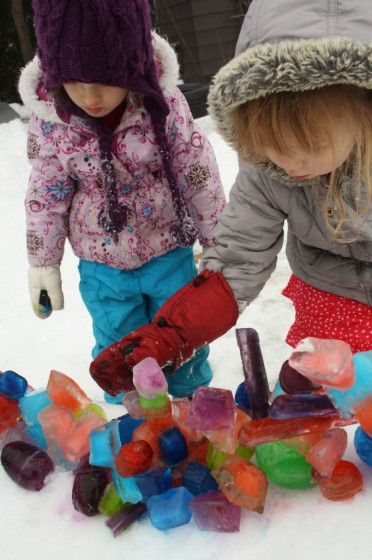
This blog’s most popular post by far remains one of its simplest: 50 Ways to Explore Nature in Your Own Backyard. I’m glad to know that so many people are looking for ways to spend time in nature right outside their own homes.
Since that post remains a hit, I thought it might be helpful to compile a list of ideas for backyard fun for every season – starting with winter.
This list includes a combination of things we’ve tried in the past and things we’d like to try soon (especially all those snow play ideas!). Hope one or more of them will inspire you to head outdoors and spend some time exploring nature.
Go on a winter nature scavenger hunt
Create rain art
Search for nests
Make chalk drawings in the rain
Roll down a hill
Make a winter home for the birds
Catch raindrops on your tongue
Take a photo safari
Enjoy a backyard campfire
Blow colored bubbles in the rain
Run down a hill
Take a walk in the rain
Float a homemade boat in a puddle
Have a picnic
Plus some snow play ideas for those of you who need some ’em:
Create snow angels
Go sledding or tubing
Have a snowball fight
Make ice ornaments
Search for tracks in the snow
10 Christmas Nature Activities
Decorate with nature for the holidays
Make a holiday card tree
Go on a neighborhood holiday lights walk
Create an ornament from nature
Make birdseed ornaments
Make twig stars
String fresh garland for the birds
Head to a Christmas tree farm
Have a Christmas-themed picnic
50+ Spring Nature Activities for Kids
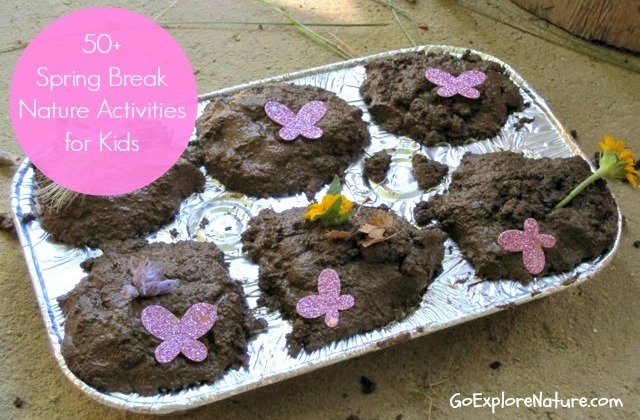
Whether your kiddos are heading to day camp or hanging out at home, spring break is a great chance for some unstructured nature play, local exploring, even an outing to a nearby state or national park! Here are 50+ spring break nature activities for kids to help encourage some outdoor fun. And if travel is on the agenda, make a point to schedule in some time to connect with nature during your trip.
Backyard nature play
Take advantage of spring break to let the kids have plenty of time for unstructured nature play every day. A few ideas for outdoor play spaces that encourage connecting with nature:
Backyard beach or other sand play area
Mud pie kitchen (we also love a mud bath area)
Water play area
A kid’s-only zone (like a fort, tree house, or other secret hideaway)
Local nature exploring
Whether it’s in your own backyard, a local park or a nearby nature destination, find some time to let the kids do some exploring. Some timely activities:
Go on a spring nature scavenger hunt.
Create a fairy garden.
Search for four-leaf clovers.
Explore a flower up close.
Visit a local garden or arboretum.
Take a color walk.
Make wind streamers.
Walk barefoot through the grass.
Arrange a flower bouquet.
Do some bird watching.
Head to a local farm for a u-pick adventure.
Plant a garden.
Pick dandelions.
Go for a bike ride.
Have a picnic.
Start a nature journal.
Go on a bug hunt.
Grander adventures
Support your local parks! If you’ve got a day free – or even just a few hours – head to a regional, state or national park. While you’re there, you may be able to:
Take a hike.
Visit a nature center.
Participate in a junior ranger program.
See some wildflowers in bloom.
Visit a pond.
Meet a park ranger.
Watch a sunset.
And if it rains …
Spring Nature Photo Scavenger Hunt
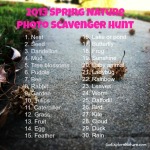
It’s official: Spring has begun!
Which means it’s time to kick off the spring nature photo scavenger hunt.Here’s how it works: I’ve come up with 30 things you and your kiddos can “hunt for” outside this spring. Find an item, snap a picture and check the item off your list. Will you be able to find everything before summer gets here?Don’t worry if your little explorer isn’t an … [Read more...]
Make a Spring Outdoor Fun List
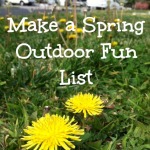
Just before the start of each season, the hubby, Explorers and I get together to create our family’s seasonal outdoor fun list. What’s an outdoor fun list? It’s a bucket list of things you’d like to do outside during that season. Making one is an excuse to talk about all the fun coming in the weeks and months ahead – especially handy when the weather is still cold and icky … [Read more...]
Celebrate the Spring Equinox With Kids
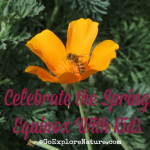
On March 20, the Spring Equinox will arrive to officially mark the first day of spring (in the Northern Hemisphere, that is). In case you’re like me – not quite sure what an “equinox” is – let me share. It’s when the sun crosses directly over the Earth’s equator, and day and night are the same length. It happens twice a year, in March and September. Spring is marked by … [Read more...]
Backyard Play Spaces: Nature Play Station
Little Makers and Explorers
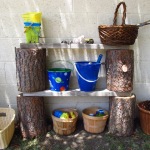
Earlier this month, I shared some of the summer backyard play spaces we’re planning. Today I’m ready to unveil the first of these spaces, our nature play station. How it’s made: I took a couple of unused wood planks we had lying around the backyard and placed them across some tree stumps we inherited last fall. The result is a shelving unit that makes for a perfect nature … [Read more...]
Gearing Up for Summer Nature Fun
Little Makers and Explorers
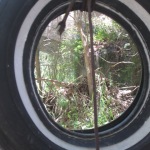
The Big Explorer is out of school in just 6 short weeks. And unlike last year, I’m not waiting until the first day of summer vacation to get ready. There’s plenty I can do now to prepare – which appeals quite nicely to my inner planning freak.Here’s what’s on my summer to-do list:Start inside – in the closets, to be precise.Does everyone have shorts, shirts and shoes that fit? … [Read more...]
My Friday 5: A Celebration of Trees
Little Makers and Explorers

Psst. I’m a little giddy on nature today. Know why? It’s National Arbor Day. What’s that, you ask? The Arbor Day Foundation suggests it is a time to celebrate the wonders of nature, and to plan for an even greener future by planting and caring for trees. I love trees. When I head to the forest and am surrounded by them, I feel at home. I am in awe of their strength and … [Read more...]
10 Ways to Explore Nature in April

Spring is in the air and the incentive to head outdoors is stronger than ever. It doesn’t hurt that April is full of nature celebrations – including Earth Day, Picnic for the Planet, and the Children & Nature Network’s Let’s G.O.! (Get Outside) event. If you’re looking for a few easy ways to spend time in nature this month, you’ve come to the right place. Along with this … [Read more...]
Superscript
Outdoor Explorations and Adventures
Lake and River Activities
That's the Difference Between a Lake and a Pond?
Lake Activities for Kids
Activities with Rocks and Stones for Kids
River-bottom Bones: The Strange World of Underwater Fossil
Top 10 Ideas for Small Water Features
What's the Difference Between a Lake and a Pond?
10 Tips for Father and Son Bonding
How to Carve Out Mother-Daughter Bonding Time
Lake and River Activities for Kids
Easy Outdoor Science Experiments For Kids
Bird-Watching Activities for Kids
Fun Physics Activities for Kids
Ocean and Beach
How Rip Currents Work - HowStuffWorks
How Ocean Currents Work - HowStuffWorks
How Deep Is the Ocean? - HowStuffWorks
Can You Name These Beach Movies From Just One Image?
What Causes Tides? High and Low Tides Explained - HowStuffWorks
Should You Take a Conch Shell From the Beach?
Can You Tell If a Sand Dollar Is Alive Before Taking It Off the Beach?
NASA's Astronaut Beach House Is a Little-known Gem of Space History
How to Draw a Tropical Beach Scene
10 Great Snack Ideas for the Beach
That Blob on the Beach Is Sea Pork
FAMILY FUN
Easy Science Activities for Kids
Bird-Watching Projects for Kids
Rock and Mineral Activities for Kids
5 Basketball Variations to Play in Your Backyard
5 Volleyball Variations to Play in Your Backyard
Pebble Games and Activities for Kids
5 Most Dangerous Recreational Sports (with the most ER visits)
Tennis Games and Activities for Kids
How to Create a Backyard Treasure Hunt
Easy Science Experiments For Kids
Oktoberfest Activities for Kids
Fun Physics Activities for Kids
Easy Nature Activities for Kids
Environmental Science· Engineering · Life Science· Physical Science
How to Bond With Kids Over Video Games
10 Things Tweens Actually *Want* to Do After School
How to Stay Involved with Your Tween Without Hovering
Easy Halloween Crafts for Kids
Ultimate Guide to Parenting Classes
5 Cheap Family Activities That Kids Love
Activities for Kids with Speech Impediments
Activities for Kids with Learning Disabilities
10 Cool Father-Daughter Activities
10 Great After-School Activities for Tweens
Activities for Visually Impaired Kids
How to Build Family Traditions
10 Technologies that Bring the Family Closer
How to Create Family Keepsake Photo Albums
ADVENTURES
10 Family Fun Activities You Can Do at a Park
A Guide to Hiking in the Adirondacks
10 Tips for Family Camping Meals
10 Things to Bring on a Family Camping Trip
Easy Beach Activities for Kids
American Flag Crafts and Activities
5 Ways to Slow Down and Enjoy Your Next Family Vacation
Family Celebrations: Fourth of July Festivities
10 Mommy and Me Activities to Try
How do you put together a family night with your teens?
Nature Garden Activities for Kids

